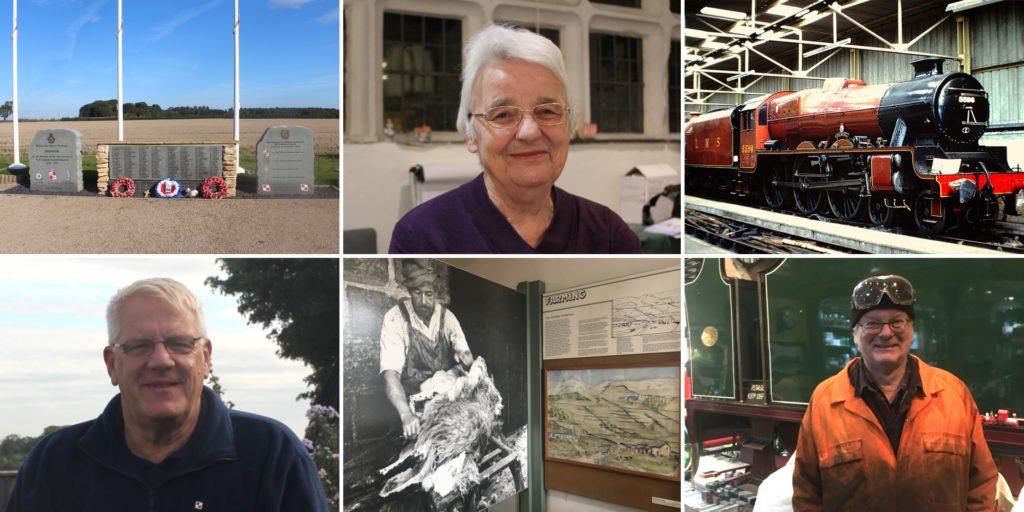Curating complex lives and legacies
When: 22nd March 2024, 18:00 — 19:30
Venue: Keynes Library, Birkbeck. 43 Gordon Square. Map here.
Cost: Free, but you must book as we have limited availability.
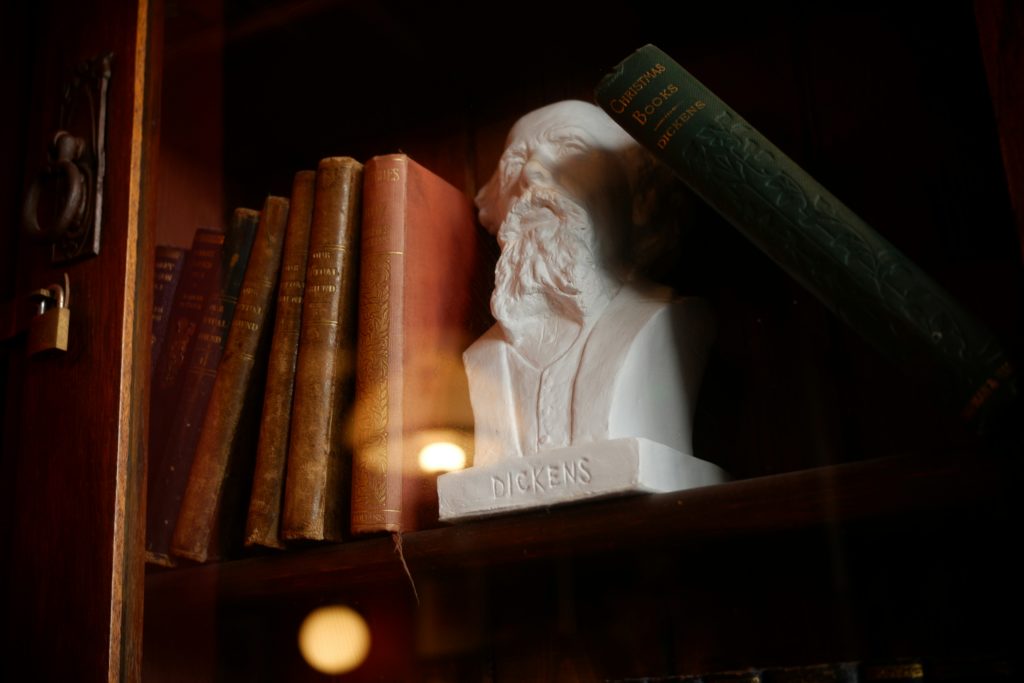
Increasingly museums are required to address the lives and legacies of complex historical figures. They must also adhere to the demands of their key stakeholders – some of whom have a personal interest in the lives of the figures being represented.
In this discussion, Kate Clements (Imperial War Museums) and Frankie Kubicki (Dickens Museum) discuss the unique challenges of representing figures like Winston Churchill and Charles Dickens in the museum space. From appropriately addressing divisive legacies, to having insufficient collections to properly represent personal histories, this event is designed to generate conversation about how museums navigate the challenges and changing expectations of including biographical histories in exhibitions.
Kate Clements has worked at Imperial War Museums since 2006. She has curated a number of exhibitions at IWM London, including the permanent, award-winning Second World War Galleries, the Victoria Cross and George Cross Gallery, Extraordinary Heroes, and Crown and Conflict: Portraits of a Queen in Wartime. Kate is the author of Total War: A People’s History of the Second World War and The Royal Family in Wartime. She has also delivered digital historical content, including a popular podcast series, Voices of the First World War. Kate is currently Curator of the Churchill War Rooms.
Dr Frankie Kubicki is the Deputy Director of the Charles Dickens Museum, London. Over the last seven years she has curated exhibitions that explored Dickens’s interest in science, how his novels tracked early air pollution, and his global impact, amongst other topics. Frankie regularly speaks to the media on Dickens’s life and work, and media credits include BBC and ITV news, as well print media including The Guardian and The Times. She previously worked as Senior Curator at Keats House in Hampstead where her interest in literary houses developed.
The event is free but you must book a place to attend and we have limited tickets available. Book here.
Photo by Daniela Muntyan on Unsplash
Behind the Scenes at the Museum: The Project to Refurbish and Redisplay the National Portrait Gallery, 2012-23
Dr Lucy Peltz
Friday 20 October 2023, 6–7.30pm
National Portrait Gallery, 39-40 Orange Street, London, WC2H 7HS
The National Portrait Gallery has recently re-opened its doors following the most extensive transformation of its building and displays since 1896. The transformation project, which was called ‘Inspiring People’, comprises a significant refurbishment of the building, a complete redisplay of the collection and a new commitment to access, inclusion, diversity and visitor welcome. Lucy Peltz was one of the steering group for the redisplay and will give an overview and a behind-the-scenes insight into the aims, objectives, challenges and achievements of ‘Inspiring People’.
About the Speaker: Lucy Peltz is Head of Collection Displays (Tudor to Regency) and Senior Curator 18th Century Collections at the National Portrait Gallery.
Bookings required by Wednesday 18 October at the latest, so that names can be supplied to the NPG in advance.
Meet promptly at the Orange Street entrance, 39-40 Orange Street, WC2H 7HS.
Soft Curating
Carolina Cerón
Monday 16 October 2023, 6–7.30pm
Keynes Library, 43 Gordon Square, London, WC1H 0PD (Map)
Carolina Cerón introduces us to the idea of ‘soft curating’, a term formally coined by the Colombian artist Gustavo Zalamea at the turn of the last Millennium. Reflecting on the original Spanish term curaduría blanda, in this interactive workshop Cerón will encourage us to consider the possibilities of curation in terms of a variety of adjectives – light, porous, gaseous, diluted, ductile. This workshop is designed for everyone interested in exploring how we might think about curating today.
About the Speaker: Carolina Cerón is Associate Professor of the Art Department at Universidad de los Andes, in Bogota, Colombia. In her work she explores the experimental possibilities of curatorial practice.
Behind the Scenes at the National Gallery
Tour with Dr Susanna Avery-Quash
Monday 6 March 2023, 4.30 – 6.00 pm
National Gallery Library and Archive, Trafalgar Square, London WC2N 5DN (Map)
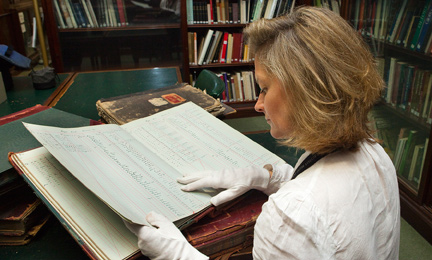
This site visit is aimed to introduce some key individuals and episodes in early decades of the National Gallery’s history around its foundation in 1824 and around its reconstitution in 1855. Our tour will start with a visit to the Library where we will talk through a select group of important historical documents related to the work of the first director Sir Charles Eastlake to professionalise the management of the gallery, including in relation to cataloguing the pictures. The second leg of the tour will take place in the main floor galleries where we will look at the very different kinds of paintings that entered the national collection at two key moments in its history: firstly, the foundation collection of John Julius Angerstein which was purchased in 1824 and secondly, Eastlake’s pioneering purchases of early Italian pictures after his appointment as first Director in 1855.
Please note: Meet at the West Entrance/Research Centre Entrance (black door labelled Research Centre to the left of the Portico Entrance).
A History of Hanging! 200 Years of Display at the National Gallery
Lecture by Dr Susanna Avery-Quash
Monday 20 March 2023, 6.00 – 7.30 pm
Keynes Library, 43 Gordon Square, London WC1H 0PD (Map)

This talk will consider the different ways in which different kinds of paintings have been displayed at London’s National Gallery since its foundation in 1824 and what this reveals about taste as well as ideas concerning the purpose of public art galleries. Originally, the small collection of Grand Manner pictures was shown in an aesthetic arrangement in a Georgian London town house in Pall Mall. After the Gallery moved into purpose-built accommodation on Trafalgar Square in 1838, the picture display became very unsystematic largely due to the chronic lack of space, which only worsened as the collection expanded. However, things radically changed after the Gallery was reconstituted in 1855, when it was decided that it should aim to become a survey collection of western European painting from its origins in the thirteenth century, and an annual purchase grant was established. Sir Charles Eastlake, appointed that year as the first Director, not only started to purchase early Italian and Netherlandish paintings, but also began to hang the entire collection by date and school, a system still used today.
Dr Susanna Avery-Quash is Senior Research Curator in the History of Collecting at the National Gallery. She is in charge of the pre-1900 objects in the Gallery’s History Collection and is responsible for activities associated with the Gallery’s research strand ‘Buying, Collecting and Display’. Her research and publications focus on important private and public art collections, especially the National Gallery; trends in artistic taste, especially for the Old Masters; and the historical art market. She is a trustee of The Society for the History of Collecting; The International Art Market Studies Association (TIAMSA); and the Francis Haskell Memorial Fund; a Fellow of the Society of Antiquaries; and is a Specialist Volunteer for the National Trust. She is an Honorary Research Fellow at Birkbeck, University of London, and at the University of Buckingham’s Humanities Research Institute.
Museum Work: Hierarchies and Barriers, Exclusion and Inclusion
Tuesday 23 May 2023, 9:30 am – 5:30 pm
Workshop, AHRC Network series Making Museum Professionals 1850 – present
Keynes Library, School of Arts Building, 43 Gordon Square, London WC1H 0PN
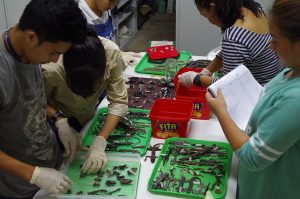
Image: Wikimedia Commons.
This event will consider particularly how hierarchies within and barriers to museum work have developed historically and are in evidence today, and how such hierarchies were and continue to be challenged and negotiated by those excluded and disempowered by museums. Confirmed keynote contributors so far include Professor Fiona Candlin (Birkbeck), Dr Errol Francis (Culture&), Louise McAward-White (Fair Museum Jobs) and Tamsin Russell (Museums Association).
Subsequent workshops of the network will consider 2) the development of training and career paths within museum practice (online, autumn 2023) and 3) transnational forces in the development of museum professionals (Berlin, spring/summer 2024).
This event is the first workshop in the AHRC Network series Making Museum Professionals 1850 – present.
The Making Museum Professionals network responds to growing campaigns in the museum sector for fairer recruitment and career structures. Across the world, campaign groups have highlighted the systems of inequality facing many of those working in and with museums. This new network will support such campaigns for fairness, inclusion and transparency, by investigating the historical roots of the museum professions and the structures that supported them, from the birth of the modern museum (c. 1850) to the present day. It asks how museum professions came into being, and how they acted to produce particular competences and ways of working. Critically, the network also seeks to develop productive links between academics and museum professionals, creating spaces, practices and outputs for dialogue between past, present and future, and to conceptualise historical practice as a tool to improve accessible professionalisation today.
Everyone is welcome but booking is essential.
For more information, call for papers, draft programme and booking, please click here.
From Mummies to Museums: In conversation with Angela Stienne
Friday 19 May 2023, 6:00 pm – 7:30 pm
Room 106, School of Arts Building, 43 Gordon Square, London, WC1H 0PN
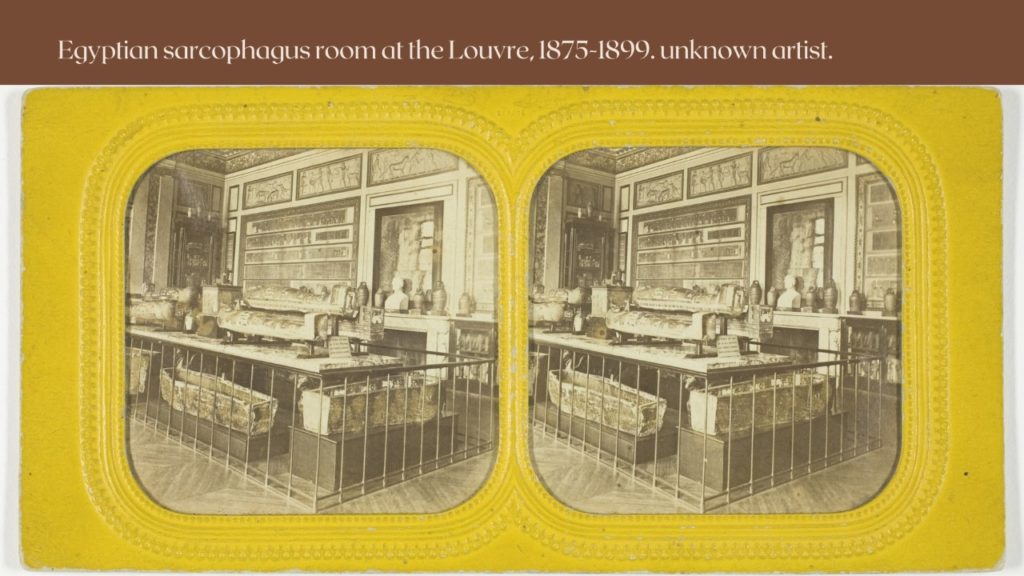
Mummified human remains are so present in European museums that we often fail to observe how incongruous their presence in glass cases in local museums really is. And yet, the history of Egyptian bodies in museums is incredibly pervasive and has been a staple of European culture for centuries: from race studies to displacement, histories of conquest and collecting, to debates over ethics and repatriation, the history of Egyptian mummified bodies in museums offers a unique lens to look at the museum, and to question both past practices and contemporary questionings.
We will journey from the Musée du Louvre to the British Museum, from Leicester Museum to the Pitt Rivers Museum, from eighteenth-century collecting to twenty-first-century removal, to explore ways in which the questions surrounding the collection, retention, study, and display of human remains is paradigmatic of the museum’s struggles with its own definition and mission, past and present.

Dr Angela Stienne is a museum historian, storyteller, and founder of the project Mummy Stories (www.mummystories.com) that aims to make conversations on the ethics of human remains in museums accessible to all. She is the author of Mummified, The stories behind Egyptian mummies in museums (Manchester Uni Press, 2022) and an official tour guide at the Musée du Louvre in Paris.
Booking is essential. Please book your free place here.
A History of Hanging! 200 Years of Display at the National Gallery
Lecture by Dr Susanna Avery-Quash
Tuesday 25 April 2023, 7.40 pm – 9 pm
Keynes Library, 43 Gordon Square, London WC1H 0PD (Map)

This talk will consider the different ways in which different kinds of paintings have been displayed at London’s National Gallery since its foundation in 1824 and what this reveals about taste as well as ideas concerning the purpose of public art galleries. Originally, the small collection of Grand Manner pictures was shown in an aesthetic arrangement in a Georgian London town house in Pall Mall. After the Gallery moved into purpose-built accommodation on Trafalgar Square in 1838, the picture display became very unsystematic largely due to the chronic lack of space, which only worsened as the collection expanded. However, things radically changed after the Gallery was reconstituted in 1855, when it was decided that it should aim to become a survey collection of western European painting from its origins in the thirteenth century, and an annual purchase grant was established. Sir Charles Eastlake, appointed that year as the first Director, not only started to purchase early Italian and Netherlandish paintings, but also began to hang the entire collection by date and school, a system still used today.
Dr Susanna Avery-Quash is Senior Research Curator in the History of Collecting at the National Gallery. She is in charge of the pre-1900 objects in the Gallery’s History Collection and is responsible for activities associated with the Gallery’s research strand ‘Buying, Collecting and Display’. Her research and publications focus on important private and public art collections, especially the National Gallery; trends in artistic taste, especially for the Old Masters; and the historical art market. She is a trustee of The Society for the History of Collecting; The International Art Market Studies Association (TIAMSA); and the Francis Haskell Memorial Fund; a Fellow of the Society of Antiquaries; and is a Specialist Volunteer for the National Trust. She is an Honorary Research Fellow at Birkbeck, University of London, and at the University of Buckingham’s Humanities Research Institute.
Booking is essential for this event. Please book your free place via our Eventbrite page.
Behind the Scenes at the National Gallery
Tour with Dr Susanna Avery-Quash
Monday 6 March 2023, 4.30 – 6.00 pm
National Gallery Library and Archive, Trafalgar Square, London WC2N 5DN (Map)

This site visit is aimed to introduce some key individuals and episodes in early decades of the National Gallery’s history around its foundation in 1824 and around its reconstitution in 1855. Our tour will start with a visit to the Library where we will talk through a select group of important historical documents related to the work of the first director Sir Charles Eastlake to professionalise the management of the gallery, including in relation to cataloguing the pictures. The second leg of the tour will take place in the main floor galleries where we will look at the very different kinds of paintings that entered the national collection at two key moments in its history: firstly, the foundation collection of John Julius Angerstein which was purchased in 1824 and secondly, Eastlake’s pioneering purchases of early Italian pictures after his appointment as first Director in 1855.
Please note: Meet at the West Entrance/Research Centre Entrance (black door labelled Research Centre to the left of the Portico Entrance).
Booking is essential for this event. Please book your free place via our Eventbrite page.
The UK Museums Boom (and what happened next)
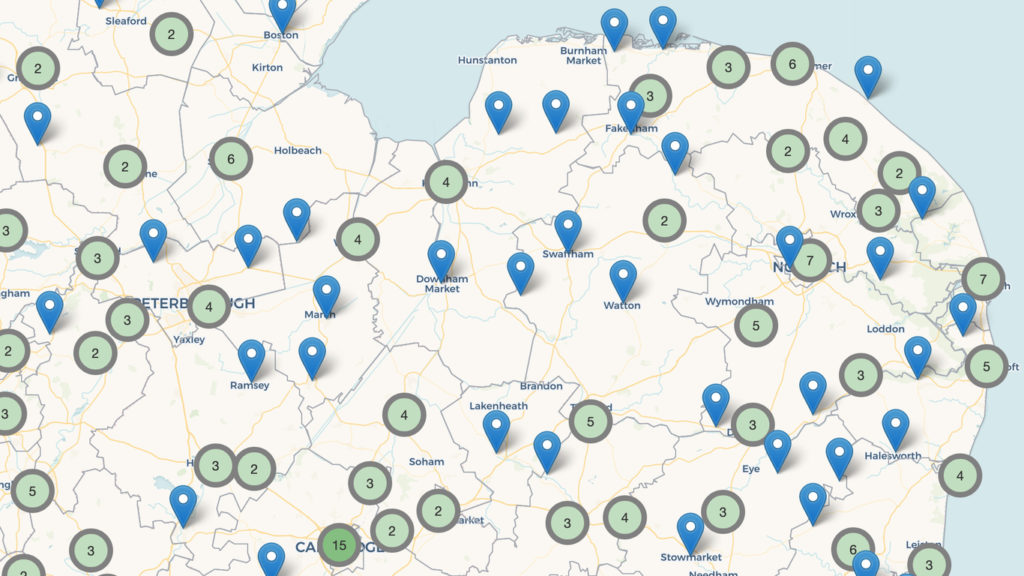
The Mapping Museums end-of-project lecture, followed by a drinks reception. Places are free but booking is essential.
Thursday 17th November 2022, 6.00 pm
Clore Management Centre, Birkbeck, 27 Torrington Square, London WC1E 7JL (Map)
Chair: Isabel Wilson, Arts Council England
Speaker: Prof Fiona Candlin, Professor of Museology, Birkbeck
Respondent: Lisa Ollerhead, Director, Association of Independent Museums
With a drinks reception to follow
Places are free but please book here: Book Tickets
During the late-twentieth century there was a significant increase in the number of museums in the UK. Yet, apart from the highly polemic heritage debates of the 1980s and 1990s, the boom was not investigated in any detail. There was no firm information on its location or character, or indeed on what happened next. The Mapping Museums project was devised to remedy that situation.
Over the last six years we have collected and analysed data on over 4,000 museums, and conducted detailed interviews with the founders of the new museums. In this lecture Prof Fiona Candlin, the project lead, will outline some of the things we learned.
Mapping Ukraine in Museums: Collections and Practices

Image courtesy of the Ukrainian Institute. Photograph by The Bohdan and Varvara Khanenko National Museum of Arts, Kyiv, Ukraine.
When: Thursday 20 October – Friday 21 October 2022, 5.00 – 8.00 PM (GMT + 1 hour)/ 7.00 -10.00 PM (Kyiv Time)
Venue: Online via Zoom.
We are thrilled to announce the Mapping Ukraine in Museums event, sponsored by the British Council and the Ukrainian Institute, and co-organised by the Centre for Museum Cultures at Birkbeck College, as part of the UK/Ukraine Season of Culture.
How to attend
This event is free and open to all.
To attend, please register via the following form (this form will open in a new tab).
Event details
The Russian invasion of Ukraine in February 2022 has reopened a new inquiry into the colonial relationship between Russia and Ukraine. It also enforced rethinking of the meaning and strategies of the decolonisation project as applied to museums. For centuries, Ukraine-born artists have been identified, as well as kept identifying themselves, as Russian artists. This event examines the following questions:
- How can we balance the exigencies of transnationality, the condition which characterizes Ukrainian arts as a whole, against the practices of cultural appropriation?
- How could museums outside Ukraine respond to those specific decolonisation issues?
- How could Ukraine be mapped into the complex geographies of their collections?
During two consecutive days, experts will discuss the place of Ukraine in the decolonization processes of museum institutions.
Day One focuses on the very issue of decolonisation and its shifting meanings, especially in the context of the war in Ukraine.
Day Two focuses on discussing the ways in which the museum world, in the largest sense of the term, could support the effort to decolonise museums in the aftermath of the Russian invasion.
The event will be broadcasted on the Zoom platform, as well as on the Facebook page of the Ukrainian Institute.
Programme
Thursday, 20 October 2022
- 5.00 – 5.30 PM GMT (+1.00)/ 7.00 -7.30 PM (Kyiv Time)
- Introduction: David Codling, British Council, Ukraine UK Season Director; Tetyana Filevska, Creative Director of the Ukrainian Institute, Kyiv, Anastasiia Yevsieieva, Visual Arts Programme Manager, Ukrainian Institute, Kyiv, Stephanie Bowry, Co-Director, Birkbeck’s Centre for Museum Cultures and Katarzyna Murawska-Muthesius, Birkbeck College, University of London
- Chair: Stephanie Bowry
- 5.30 – 5.50 PM GMT (+1.00)/ 7.30 -7.50 PM (Kyiv Time)
- Ukrainian hybrid orientalism and the paradox of decolonial disposition: Hanna Rudyk, Curator of Islamic art at The Bohdan and Varvara Khanenko National Museum of Arts in Kyiv
- The presentation will address the problems of studying and resisting the complex, multilevel and multifaceted Ukrainian coloniality which, in terms of its relations with “other”, non-European cultures, acquires a special hybrid form of orientalism. Reflections on the strategies and tools of decolonization of contemporary Ukrainian culture, in particular museums, will focus on the disposition of decolonial thinking and on the paradox of its essential a-topicity, the constant shift of the position / norm of the subject.
- 5.50 – 6.10 PM GMT (+1.00)/ 7.50 -8.10 PM (Kyiv Time)
- Decolonial approaches in CEE museum cultures: challenges and perspectives: Magdalena Wróblewska, Assistant Professor at the Faculty of “Artes Liberales”, University of Warsaw
- My presentation looks at the latest trends in the global museum’s decolonization practices, focusing not on the restitution controversies, but rather on multiple small and large scale activities that are aiming at the new discussions and understandings of various colonial pasts and postcolonial conditions in different regions of the world. I will put the emphasis mostly on the examples from Central and Eastern Europe, and try to define the challenges and perspectives of museums and collections in this region. At the end of my talk I would like to explore significant meanings of colonialism and decoloniality in this region, and to reflect how these meanings can make a shift in the global decolonial museum movement.
- 6.10 – 6.30 PM GMT (+1.00)/ 8.10 -8.30 PM (Kyiv Time)
- On de-imperializing Ukrainian modern art from museum registries: Myroslava Maria Mudrak, Professor Emerita of the History of Art, The Ohio State University
- Russia’s assault on Ukraine has not only put into relief the treacherous quest for control over one of the largest regions of the former U.S.S.R. lost to the fall of communism but has finally exposed the inherently appropriative character of imperialism and its lingering effects in the miswriting of Ukrainian art history and culture. The vast and diverse field of Ukrainian artistic modernism had long ago fallen victim to the unchallenged museum practice of assigning Ukrainian artists born in Ukraine and made stateless by imperial jurisdiction at the end of the 19th and early 20th centuries, to cultures other than its own. This presentation brings to light the insidious nature of museum labelling that unwittingly perpetuates imperial narratives.
- 6.30 – 6.50 PM GMT (+1.00)/ 8.30 -8.50 PM (Kyiv Time)
- Museum military mutual help: the experience of the Museum Crisis Centre: Olha Honchar, Director of the Memorial Museum of Totalitarian Regimes “Territory of Terror” in Lviv
- Museum Crisis Center was launched during the first days of the war by the Territory of Terror museum in Lviv, as well as NGO “Insha Osvita”, and NGO “New Museum”. The main focus of this initiative is providing financial support to individual museum workers in times of crisis. Since 3 March 2 000 000, 00 UAH were raised and distributed to 810 people from 148 institutions in 10 regions of Ukraine. During my speech, I will concentrate on the algorithm of initiative’s work, as well as on the museums network, and on solutions to the problems and on challenges, which may appear in the future.
- 6.50 – 8.00 PM GMT (+1.00)/ 8.50 -10.00 PM (Kyiv Time)
- Q&A Session and General Discussion
Friday, 21 October 2022
- 5.00 – 5.10 PM GMT (+1.00)/ 7.00 -7.10 PM (Kyiv Time)
- Introduction: Tetyana Filevska, Creative Director of the Ukrainian Institute, Kyiv and Katarzyna Murawska-Muthesius, Birkbeck College, University of London
- Chair: Tetyana Filevska
- 5.10 – 5.30 PM GMT (+1.00)/ 7.10 – 7.30 PM (Kyiv Time)
- Museums strategies during the war: reinventing itself: Yuliia Vaganova, Acting Director of the Bogdan and Varvara Khanenko National Museum of the Arts, Kyiv
- Today, the museum world raises the question of decolonization and the search for justice in relation to both the original owners of the collected items, as well as approaches of the institutions themselves to the ways of the presentation of alienated collections. However, this step is preceded by another action – the internal decolonization of the institutions and a change in the focus of the view on oneself. Most of the museums in Ukraine were built according to the Soviet propaganda matrix, or following a neutral display of works of art. Most of the institutions were within the framework of the Soviet repressive models of internal management. However, some of them began to set themselves the task of internal changes, the majority remained in the old mode of management and concepts. What conclusions can we draw today, during Russia’s war against Ukraine, and what tasks do we define as the first priority for freeing ourselves from Soviet colonial-imperial patterns? And what wartime strategies do we use for such liberation? The report is based on the case study of the Khanenko Museum in the period of 2022.
- 5.30 – 5.50 PM GMT (+1.00)/ 7.30 – 7.50 PM (Kyiv Time)
- Protecting Ukrainian Heritage – a UK response: Maria Blyzinsky, an independent curator, heritage consultant and writer, and co-founder of The Exhibitions Team
- This talk will look at the UK response to supporting museums, galleries, libraries and archives in Ukraine following the launch of full-scale war in February. Case studies will be used to identify ways for heritage professionals to incorporate changes into their daily practice, ensuring Ukrainian culture is ethically collected and appropriately interpreted.
- 5.50 – 6.10 PM GMT (+1.00)/ 7.50 – 8.10 PM (Kyiv Time)
- Odesa Fine Arts Museum: from the imperial tool to the most pro-Ukrainian space of the city: Oleksandra Kovalchuk, Acting Director of the Odessa Fine Arts Museum, Member of the Odesa City Council, leader of the NGO “Museum for change”
- History of the Odesa fine arts museum reflects constant change, turbulence and tragedies of the XX-th century that continue to impact modern Ukraine and the world. One of the best ways to look at history is through people and institutions. We could speak about city’s Imperial past, civil war, red terror of communist repressions or decades of life under the constant suppression of the totalitarian regime. Instead I suggest speaking about the history of a museum, one of many Ukrainian museums and institutions that managed to survive the XX century only to stop their development in times of full-scale invasion of the Russian Federation. Stories that live behind the Odesa fine arts museum are stories of many people who invested their efforts and, sometimes, lives to give this museum a chance for development and commitment to the society. As we are searching for new strategies for the future, we find more sense and insights in the past of the Odesa fine arts museum.
- 6.10 – 6.30 PM GMT (+1.00)/ 8.10 – 8.30 PM (Kyiv Time)
- The Time of Stalins and Hitlers is Not Over: Museums Perceiving Decolonisation after Occupation: Tehmina Goskar, Director and Curator of the Curatorial Research Centre, Post-doctoral Research Fellow at the Decolonising Arts Institute, UAL (University of the Arts London), Fellow of the Museums Association.
- How do museums across the world deal with the heritage of imperialism, autocracy, totalitarianism and tyranny? In the words of Arundhati Roy “the project of domination [is] ongoing.” In the midst and in the immediate aftermath of invasion, occupation, and genocide, the focus of museums and heritage will be on rescuing, replacing and healing. But after rebuilding and building anew what happens? Taking examples from post-Soviet Estonian museums and (nearly) post-colonial Aotearoa New Zealand we can learn about how museums can take a longer decolonial view of painful pasts that remember, reflect and reveal society and culture in all their contradictions and diversities.
- 6.30 – 8.00 PM GMT (+1.00)/ 8.30 -10.00 PM (Kyiv Time)
- Q&A and General Discussion
Speaker Biographies
Maria Blyzinsky is a UK-based heritage consultant and independent curator specialising in exhibitions and interpretation. She was Curator of Astronomy and, later, Head of Exhibitions at the Royal Museums Greenwich, where she now holds the post of Curator Emeritus. In 2007, Maria co-founded The Exhibitions Team, an association of independent museum professionals with a passion for exhibitions, collections and interpretation: www.theexhibitionsteam.com. Her clients include an array of nationally and internationally recognised names from the heritage and culture sectors, including the British Museum, V&A, Westminster Abbey, Imperial War Museum and Abbey Road Studios. She is a published author and is currently writing a book about generating ideas for exhibitions, due to be published in 2023. Maria has a longstanding interest in the use of heritage and culture as a weapon during times of war. She was an advisor to Heritage Without Borders, a now-defunct charity that trained museum professionals to work with colleagues in post-conflict countries. She is currently providing pro bono assistance to ICOM UK (the UK branch of the International Committee of Museums), helping to coordinate initiatives that support museums in Ukraine.
Tetyana Filevska is Creative Director at the Ukrainian Institute. Specialist in the field of contemporary art. Cultural activist, researcher of Ukrainian art of the 20 century, founder and curator of art projects. Author of the books “KAZIMIR MALEVICH. Kyiv Period 1928-1930″ and ” Dmitro Gorbachov. Sluchayi “. A graduate of the FLEX exchange program funded by the US government. Graduated with honors from the Faculty of Philosophy of the Taras Shevchenko National University of Kyiv.
Worked in the EIDOS Foundation Centre for Contemporary Art, in the Center for Contemporary Art Foundation, in the “Izolyatsia” – Platform for Cultural Initiatives, in the Mystetskyi arsenal team on the Educational and Public Program o The First Kyiv International Biennale of Contemporary Art “ARSENALE 2012”.
Tehmina Goskar is Director and Curator of the Curatorial Research Centre, founded in 2018 to modernise curatorial practice and support the profession’s technical and ethical skills. She is Art Fund Headley Fellow at the Museum of Cornish Life (seconded), Post-doctoral Research Fellow at the Decolonising Arts Institute, UAL (University of the Arts London), Fellow of the Museums Association, former member of its Ethics Committee, Accredited Facilitator, and Honorary Fellow at Swansea University. In 2016-18 I was Arts Council England Change Maker. Tehmina Goskar is a practitionerresearcher, having curated 30+ exhibitions and collections research projects, lectured internationally on collections, material culture and heritage, and trained and mentored around 100 diverse people in curatorial practice.
Olha Honchar is a culturologist, project and communications manager, anti-crisis manager. Director of the Memorial Museum of Totalitarian Regimes “Territory of Terror” in Lviv. Her research focuses on the features of PR, cultural and museum management in Ukraine, in particular in the regions. Communicator of the projects Cultural diplomacy between the regions of Ukraine in the frontline and liberated cities of Donetsk and Luhansk regions: “The museum is open for renovation”, the expedition “HERE AND THERE”, and others. Co-curator of the experimental exposition of the Anti-Terrorist Operation at the Luhansk Regional Museum in Starobilsk. Initiator of the Museum Crisis Center and the Ambulance Museum project, which emerged in the first days of the Russian war against Ukraine.
Oleksandra Kovalchuk is Acting Director of the Odesa Fine Arts Museum, Member of the Odesa City Council, leader of the NGO “Museum for change”. NGO “Museum for change” was founded in 2016 to facilitate fundraising and emancipate museum Odesa. After February 24th we help Ukrainian museum professionals that have language or skills barriers to receive support from international organisations. We’ve helped more than 50 cultural institutions to receive emergency aid for more than 800 000 euro and continue our work.
Myroslava Maria Mudrak isProfessor Emerita of the History of Art, The Ohio State University, specialising in the field of modernist art of the late nineteenth and early twentieth centuries. Her scholarly interests focus on Eastern Europe, Ukraine, Russia and the former Soviet Union in relation to the philosophical and stylistic developments of the West. For more than three decades, she taught at The Ohio State University, and lectured on the ideological discourses, socio-political influences, and artistic practice within East European cultures that use modernity to signify national identity. Mudrak’s seminal work, New Generation and Artistic Modernism in Ukraine (1986), was awarded the Kovaliw Prize for Ukrainian Studies and was published in a Ukrainian translation by Rodovid Press in 2018. Other publications include essays on Ukrainian Dada and Dissidence, Propaganda Pavilions, the Ukrainian Studio of Plastic Arts in Prague, Panfuturism, and Constructivism. She has contributed essays for exhibition catalogues on collections of Russian and Ukrainian avant-garde art, to include Red Horizon (2018); David Burliuk 1882-1967: Futurism and After (2008); From the Lotus to the Sickle: the Art of Borys Kosarev (2012); and curated the exhibition Staging the Ukrainian Avant-Garde of the 1910s and 1920s, whose catalogue was recognized by the 2016 Alfred H. Barr, Jr. Award for Smaller Museums, Libraries, Collections, and Exhibitions under the auspices of the College Art Association. Her latest publication on Ukraine’s premier modern graphic designer, The Imaginative World of Heorhii Narbut and the Making of a Ukrainian Brand (2020), has been translated into Ukrainian and French (2021). In 2020, Mudrak was elected as a Foreign Member to the National Academy of Arts of Ukraine. She is a full member of the Shevchenko Scientific Society of America.
Katarzyna Murawska-Muthesius was Curator and Deputy Director of The National Museum in Warsaw. She also taught art history at Birkbeck College, University of London and at the Humboldt University Berlin. Her publications include Borders in Art: Revisiting Kunstgeographie (Polish Academy 2000); National Museum in Warsaw Guide: Galleries and Study Collections (National Museum in Warsaw 2001); Kantor was Here: Tadeusz Kantor in Great Britain (Black Dog 2011, with Natalia Zarzecka), From Museum Critique to the Critical Museum (Ashgate 2015, with Piotr Piotrowski); Imaging and Mapping Eastern Europe: Sarmatia Europea to the Communist Bloc (Routledge 2021).
Hanna Rudyk, PhD, is a Deputy Director General in charge of education and communication, and a curator of Islamic art at The Bohdan and Varvara Khanenko National Museum of Arts in Kyiv, Ukraine. Her curatorial contribution (since 2002) included the development of the recent permanent exhibition of Islamic art (2006), as well as numerous research, curatorial and publication projects on Islamic and Asian art, the history of the Khanenko Museum and its founders. In 2005-2007 she coordinated the “Matra-Museums of Ukraine” international grant project on museum management and education. As Deputy Director in charge of education (since 2011) Rudyk initiated and coordinated the first museum visitors’ survey (2013) that fed in the development of the new Khanenko Museum outreach programming strategy, addressed to various audiences, including people with disabilities and other socially vulnerable communities. Rudyk’s professional interests include history and museology of Islamic art, coloniality and decolonization of culture and museums; history of the Khanenko family and the Khanenko Museum; innovation in museum education, inclusion, and participation. The Russian war in Ukraine prompted her new research project on the experience of decolonizing museums of non-European (primarily) Islamic and Asian Art in Europe (grants of Prussian Culture Heritage Foundation and Alexander von Humboldt Foundation).
Magdalena Wróblewska is Assistant Professor at the Faculty of „Artes Liberales”, University of Warsaw. In 2015-2020 she was responsible for research activities in the Museum of Warsaw, where she co-curated the new main exhibition, The Things of Warsaw (2017). She has received several fellowships: Lieven Gevaert Centre for Photography, Katholieke Universiteit Leuven (2010), Kunsthistorisches Institut in Florenz – Max Planck Institute and Staatliche Museen zu Berlin (2012-2014), Ruskin Library – Lancaster University (2014), Henry Moore Institute in Leeds (2015). Awarded with research grant by National Science Center in Poland (2012), and prize of the Polish Art Historians Association for her PhD dissertation (2014). In 2018-2021 she has been an investigator in a research project European Colonial Heritage Modalities in Entangled Cities (Horizon 2020), in a work package about museums’ colonial pasts. Her recent publications include Practicing Decoloniality in Museums: A Guide with Global Examples, with Csilla Ariese, Amsterdam 2021, and ‘Duality of Decolonizing: Artists’ Memory Activism in Warsaw’, with Ł. Bukowiecki and J. Wawrzyniak, Heritage & Society, 2021.
Yuliia Vaganova is an art historian, art manager, curator and currently Acting Director of the Bohdan and Varvara Khanenko National Museum of Arts in Kyiv, Ukraine. From 2016-21, she was Deputy Director for Exhibition and Museum Projects at Mystetskyi Arsenal and before that Deputy Director for Exhibition, Partnerships, and International Projects at the National Art Museum of Ukraine. She also directed the Center for Contemporary Art at NaUKMA, Kyiv, from 2005-09. In her various institutional roles, she has participated in strategic development, as well as the implementation of educational programs and various museum exhibitions. She initiated and has led a number of training programs focused on developing arts institutions, transformation processes, communication strategies, as well as promoting https://www.facebook.com/UkrainianInstitute/videos. In the summer of 2022, she took part in a research project with German university partners, exhibiting “The Khanenko Museum, Kyiv,” a haunting photographic portrait of the museum’s empty rooms.
Anastasiia Yevsieieva is Head of Visual Culture at the Ukrainian Institute, where she represents the Visual Arts sector and runs several programmes, including the international exhibition support programme Visualise. Prior to joining the Institute in 2019, she worked as a cultural manager and independent curator. In 2019, she co-curated the National Biennale for Young Art “Looks like I’m Entering Our Garden” in Kharkiv, Ukraine.
Whatever It Takes: The Resilience of UK Museums During the First Year of the Coronavirus Pandemic
When: Monday 27 June, 18.00-19.30.
Venue: Online. A recording can be found on our YouTube channel here:
Although the UK museums sector has experienced any number of exogenous shocks, few have had the destructive potential of the COVID-19 pandemic. Following closely on the long-lasting impact of the 2008 worldwide financial crisis, it might have been expected to be catastrophic for many museums. This talk explores the means by which the financial risks it posed have been mitigated – at least for the time being – through support of government and other funders, entrepreneurial spirit and effective governance. Using data from a sample of over 1,200 museum organisations, the response to the pandemic will be evaluated and, as Coronavirus transforms from pandemic to endemic, the implications for the coming years considered.
Adrian Babbidge has a long experience in the museums and heritage sector as a curator, manager, cultural bureaucrat and consultant, latterly specialising in governance, financial, legal and strategic management. His current research interests include the use of data to inform museum policy and planning, in connection with which he continues to develop his statistical observatory to help develop a longitudinal perspective on changes in UK museums.
The Avant-Garde Museum: Panel Discussion
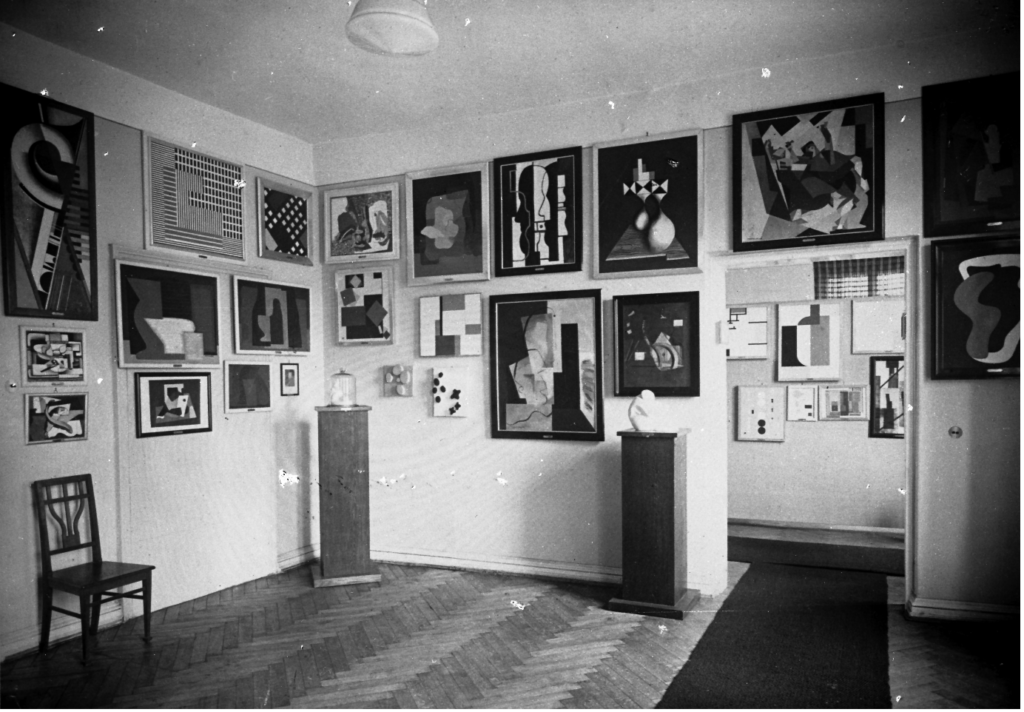
When: Thursday 12 May, 18.00-20.00.
Venue: Online via Microsoft Teams.
The event, spurred by the publication of the book by the Muzeum Sztuki in Łódź, will raise issues related to the museumization of the avant-garde in Europe and America in the 1920s. It will also present one of the earliest museums of the avant-garde which was set up by a group of Polish artists in the industrial city of Łódź in 1931.
Confirmed speakers: Professor Christina Lodder; Professor Janet Marstine; Dr Katarzyna Murawska-Muthesius (Moderator); Agnieszka Pinder; Jarosław Suchan and Vita Susak.
The Avant-Garde Museum is the first study focusing on the avant-garde’s auto-institutionalization. It compares several (quasi) institutions of the avant-garde established between World War I and World War II: Museums of Artistic Culture in post-October Russia, Kabinett der Abstrakten designed by El Lissitzky for the Landemuseum Hannover in 1927, the activities of the Société Anonyme Inc., founded in New York in the early 1920s, and the International Collection of Modern Art of the “a.r.” group opened to the public in 1931 at the City Museum in Łódź. Critical studies by major scholars of the historical avant-garde are accompanied by translations of rarely discussed texts, reproductions of unknown archival sources, as well as art works. The Avant-Garde Museum includes contributions by Jarosław Suchan and Agnieszka Pindera, as well as Masha Chlenova, Maria Gough, Jennifer R. Gross, Frauke V. Josenhans, Sandra Karina Löschke, Daniel Muzyczuk, Rebecca Uchill, ok group (J. Myers and J. Szupińska), Marcin Szeląg, and Tomasz Załuski.
Speaker Biographies:
Professor Christina Lodder
Christina Lodder specialises in Russian art of the early twentieth century. She is President of the Malevich Society, and co-editor of Verlag Ferdinand Schoeningh’s (formerly Brill’s) Russian History and Culture series. Her numerous publications include Russian Constructivism (1983); Constructing Modernity: The Art and Career of Naum Gabo (co-author, 2000); Gabo on Gabo: Texts and Interviews (co-editor, 2000); Constructive Strands in Russian Art (2005); Rethinking Malevich (co-editor); Utopian Reality: Reconstructing Culture in Revolutionary Russia and Beyond (co-editor, 2013); Aleksei Gan’s Constructivism (translator, editor, 2013); and Celebrating Suprematism: New Approaches to the Art of Kazimir Malevich (editor, 2019).
Professor Janet Marstine, Honorary Associate Professor (retired), School of Museum Studies, University of Leicester; Museum Ethics Scholar and Consultant
Janet Marstine is currently an independent scholar and consultant based in Maine in the US. She writes on diverse aspects of museum ethics from curatorial ethics to negotiating the pressures of self-censorship to artists’ interventions as drivers for ethical change. She has a particular interest in recognising and supporting the agency of practitioners to make informed ethical decisions. She sat on the Ethics Committee of the UK’s Museums Association from 2014-2019, helping to move their approach from one of policing to empowering.
Dr Katarzyna Murawska-Muthesius, Associate Lecturer in the Department of Art History, Birkbeck and Research Fellow at the Centre of Museum Cultures
She was Curator (1980-1997) and Deputy Director (2009-11) of the National Museum in Warsaw. Among her recent publications are From Museum Critique to the Critical Museum (Ashgate 2015, with Piotr Piotrowski); Imaging and Mapping Eastern Europe: Sarmatia Europea to the Communist Bloc (Routledge 2021).
Agnieszka Pindera, Head of the Research Center at the Muzeum Sztuki in Łódź
Agnieszka Pindera is interested in cultural policies, history of art institutions, including grassroots and independent initiatives. She has edited a series of books on artists’ self-organization (Practical Guide for Artists), and a history of alternative exhibition institutions (Artist-run Initiatives and Galleries) in collaboration with Anna Ptak and Wiktoria Szczupacka. She is the author of a biography of Józef Patkowski, the founder of the Polish Radio Experimental Studio, a center established in 1957 to stimulate experimental interdisciplinary work (Patkowski: Ambassador of Music from Planet Mars). She curated an exhibition by Konrad Smoleński at the Polish Pavilion during the 55th International Art Exhibition—La Biennale di Venezia (with Daniel Muzyczuk), as well as at the Centre PasquArt (Biel/Benne) and Zachęta National Gallery of Art (Warsaw).
Jarosław Suchan, Former Director of Muzeum Sztuki in Łódź
An art historian, critic, and curator, with a focus on the avant-garde, modernism, and institutional critique. In recent years, he has prepared monographic exhibitions of Katarzyna Kobro and Władysław Strzemiński, shown in the most important European museums. His exhibitions of Polish and international art have been presented at the Centres G. Pompidou Paris, Museo Reina Sofia Madrid, Serralves Museum Porto, Gemeentemuseum The Hague, Moderna Museet Malmö, Kunsthaus Graz, Zachęta Gallery Warsaw, and the Muzeum Sztuki Łódź. He is also the author of numerous texts on modern and contemporary art, and editor or co-editor of books on Władysław Strzemiński, Tadeusz Kantor, Jerzy Grotowski, and the Polish-Jewish avant-garde.
Vita Susak, Independent Scholar
With a Ph.D. in Art History, Susak is an independent researcher, curator, and expert of the Ukrainian Cultural Foundation at the Ministry of Culture of Ukraine (Kyiv). In 1992–2016, Susak headed the Department of Modern European Art at the Lviv National Art Gallery, where she curated 28 exhibitions. She taught at the Ivan Franko National University in Lviv (2011–2015). She was awarded research grants from the Getty Foundation (the USA, 1997), the Maison des Sciences de l’Homme (France, 2000, the Diderot fellowship), the Ministry of Culture of Poland (2006), the Landis & Gyr Foundation (Switzerland, 2006), and the Fulbright Fellowship (the USA, 2008). She authored numerous publications, including two monographs: Ukrainian Artists in Paris, 1900–1939 (2010) and Alexis Gritchenko: Dynamocolor (2017). Since 2016, Vita Susak lives and works in Switzerland.
V&A East: A New Storehouse and Museum
with Dr Gus Casely-Hayford
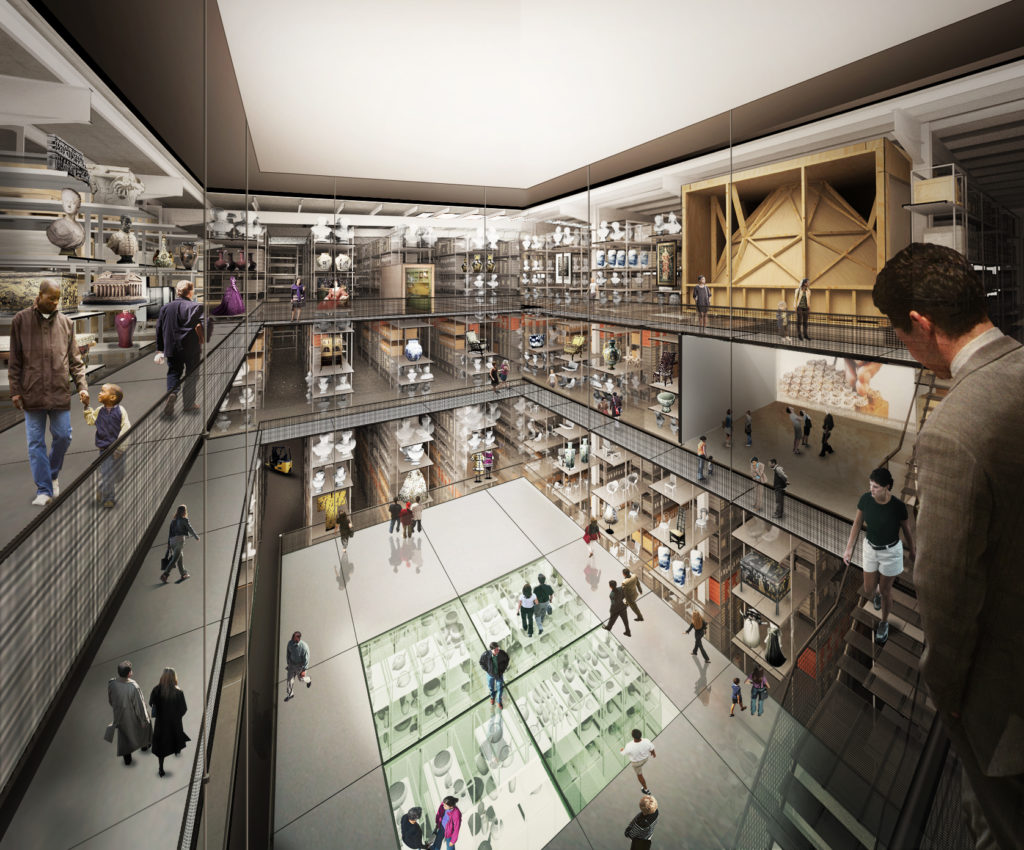
When: Friday 29 October, 18.00-19.30
Venue: Online (You can watch the recording on our YouTube Channel, here)
V&A East is a new cultural institution that builds on the V&A’s long-standing history in east London and our founding mission to make the arts accessible to all. We want to amplify the role museums play as platforms for discovery, hope and conversation in our rapidly changing world, and we will craft a creative campus, a social space with a global outlook that is truly embedded within its local community. We want to create relaxed and inclusive spaces, to welcome people who may not have felt museums were for them in the past, to empower young people – not only by radically increasing access to the cultural industries and opening up our national collections – but by bringing them with us on the journey.
Dr Gus Casely-Hayford, OBE, Prof by Practice (SOAS), the founding Director of V&A East, a museum and collection centre presently under construction. He was previously the Director of the Smithsonian, National Museum of African Art and is a curator and cultural historian who writes, lectures and broadcasts widely on culture.
Over the course of his career, Casely-Hayford has been a constant champion for the arts. He has presented two television series of The Lost Kingdoms of Africa for the BBC (and wrote the companion book), two television series of Tate Britain: Great Art Walks for Sky and has worked for every major British TV channel. His TED talk on Islamic culture has been viewed more than a million times. Former Executive Director of Arts Strategy, Arts Council England, (Britain’s major Art’s funder) and Ex-Director of the Institute of International Contemporary Art, he has offered leadership to both large and medium scale organizations. Dr Casely-Hayford has lectured widely on art and culture, including periods at Sotheby’s Institute, Goldsmiths, Birkbeck, City University, University of Westminster and SOAS. He has advised national and international bodies on heritage and culture including the United Nations and the Canadian, Dutch and Norwegian Arts Councils. In 2005 he deployed these leadership, curatorial, fundraising and communications skills to organise the biggest celebration of Africa Britain has ever hosted with Africa 2005 when more than 150 organisations put on over 1000 exhibitions and events to showcase African culture.
Amongst a range of honours, he has also been awarded a Kings College cultural fellowship for service to the arts and a SOAS Honorary Fellowship for service to Africa. He speaks widely, gave a SOAS Centenary lecture, judged the Art Fund’s British Museum of the Year award, advised the Royal Shakespeare Company on their production of Hamlet and is a member of English Heritage’s ‘Blue Plaques Group’.
Contemporary Practices of Display: Panel Discussion

When: Wednesday 22 September, 18.00-19.15
Venue: Online (Follow this link to watch the event recording)
Organised in collaboration with The Peltz Gallery, as part of the Into View festival.
How has the pandemic influenced the creation, display and reception of art within gallery settings? What impact has it had on the ways that museums and galleries work with artists and audiences? What new demands and pressures has the pandemic generated, and what new insights and practices might stay with us in post-pandemic times? Priyesh Mistry (National Gallery) and Dee Haughney (October Gallery) discuss these urgent questions. Chaired by Sarah Thomas (Director, Birkbeck Centre for Museum Cultures).
Dee Haughney will explore how the October Gallery adjusted during the pandemic by implementing new modes of display in order to continue to reach its international and local audiences. She will particularly focus on the rise and development of the online art fair and virtual exhibitions.
Priyesh Mistry will focus on the impact of the pandemic on the experience of artists working with institutions and maintaining a studio practice through the example of the 2020 National Gallery Artist in Residence: Rosalind Nashashibi. The artist residency is a one-year programme that is awarded to a jury-nominated and internationally recognised artist, to use the National Gallery’s on-site studio, display a new work in the context of the Gallery’s collection, and produce an acquisition that will enter a non-London based UK public collection.
Biographies:
Originally from Ireland, Dee Haughney is Curator of the October Gallery, which has been instrumental in bringing to worldwide attention many of the world’s leading international artists, including El Anatsui, Rachid Koraïchi and Romuald Hazoumè. Over the past decade with the gallery she has organised numerous exhibitions, art fairs and major installations with a particular interest in Contemporary Art from Africa.
Priyesh Mistry is Associate Curator of Modern & Contemporary Projects at the National Gallery, London where he works towards an ambitious programme to integrate contemporary art within the context of the museum and its historic collections. He manages the Artists in Residency programmes and contemporary commissions, including the recent exhibition Rosalind Nashashibi: An Overflow of Passion and Sentiment, and upcoming projects with Ali Cherri and Nalini Malani. Previous to this, he was Assistant Curator, International Art at Tate Modern where he specialised on art from South Asia for the collection and co-curated the Hyundai Commission 2019: Kara Walker in the Turbine Hall, the major retrospective on Anni Albers (2018) and the group exhibition Soul of a Nation: Art in the Age of Black Power (2017) as well as numerous collection displays.
Museums and Restitution
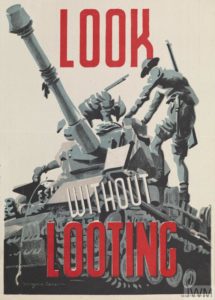
When: Monday 5 July, 18.00-19.30
Venue: Online (You can watch the recording on our YouTube Channel, here)
Countless museums hold objects in their collections that their very own codes of ethics would bar them from acquiring today. The most striking examples of this glaring discrepancy are objects captured during military campaigns outside Europe in the 19th and early 20th centuries. While museums historically considered the acquisition of these objects legal and unproblematic, it would now be unthinkable to set about acquiring objects that, for example, were looted during recent conflicts in Iraq, Afghanistan or Syria. This remarkable incongruity lies at the heart of the restitution debate which has robustly challenged traditional certainties and opened up a vital and complex debate about the nature and role of museums and the morality of their collections. Museums are being confronted with increasing calls not only to acknowledge and condemn this violent past, but also to take visible actions to redress this dark legacy. This includes the morally and legally complex issues of the restitution and repatriation of such objects to their countries of origin. This talk will address these issues by exploring how one of the UK’s major museums – the Victoria & Albert Museum – has dealt with restitution cases, ranging from Nazi-looted art to Colonial-era artefacts.
Bio: Dr Jacques Schuhmacher is the Rosalinde and Arthur Gilbert Provenance and Spoliation Curator at the Victoria & Albert Museum. He is the co-curator of “Concealed Histories: Uncovering the Story of Nazi Looting”, the first special provenance display by a UK museum, and the convenor of the Provenance and Spoliation Research Seminar Series at the V&A. He is a member of the National Museum Directors’ Council (NMDC) Spoliation Working Group which coordinates the provenance research efforts of the UK’s national museums in this area. He holds a DPhil in History from the University of Oxford
Alice Proctor: Who is at Home in the Museum?
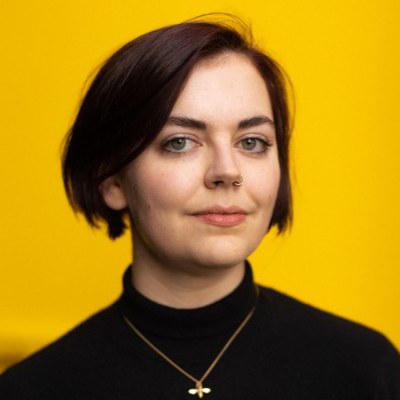
This event is organised by the Peltz Gallery
When: 28 June 2021, 18:00 — 19:00
Venue: Online – Book your place
Museums are spaces that narrate and shape national identity. They rely on the idea of a shared heritage, some sense of universal experience. But these spaces are exclusionary, and they rely on stories that comfort and confirm the biases of their implied audiences. How can we challenge the colonial legacies of museums, work through the ways they make us feel, and learn to come to terms with the discomfort of the histories they represent?
Alice Procter is an art historian, writer, and educator. Since 2017, she has run the Uncomfortable Art Tours, unauthorised guided tours of national collections, exploring how major institutions came into being against a backdrop of imperialism. She is the author of The Whole Picture: the colonial story of the art in our museums and why we need to talk about it (Cassell 2020). Her work concentrates on the intersections of postcolonial art practice, the curation of historical trauma, and narratives of national identity.
This event was originated from (Un)processed, an event series originally planned to take place in March 2020.
Penny Siopsis in Conversation with Annie E. Coombes
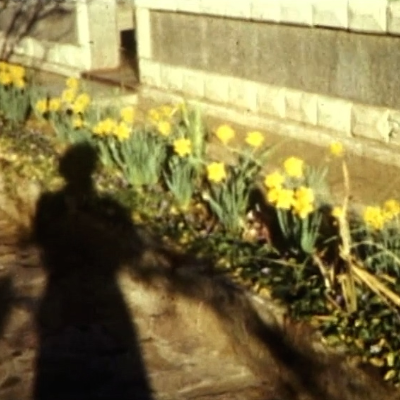
When: 14 June 2021, 18:00 — 19:30
Venue: Online
This event was organised by The Peltz Gallery
South African artist Penny Siopis discusses her Peltz Gallery commission Shadow Shame Again and her wider practice with Professor Annie E. Coombes (Birkbeck), followed by a Q&A.
During the event, Siopis will present extracts and images from previous works. Shadow Shame Again can be viewed now on the Peltz Gallery website.
Shadow Shame Again (2021)
Amid the COVID-19 pandemic, many people in South Africa have protested ‘the other pandemic’, referring to the proliferation of gender-based violence under the conditions of lockdown. Material published by UN Women shows that gender-based violence has increased globally during this time. Penny Siopis’ video artwork responds to this situation by speaking to the visceral emotion of shame. Using footage from her collection of found 8mm home movies (acquired from flea markets and charity shops), Siopis sets fragments of image sequences to words and sound. The work is a poetic evocation of ‘shadow shame’ as something that both embodies the loss of dignity and integrity, and offers fertile ground for empathy.
Penny Siopis is a South African artist who is also honorary professor at the Michaelis School of Fine Art, UCT. Working across media, all her explorations, whether with body-politics, memory, migration and grief or the relations between the human and the non-human, are characterized by what she calls the ‘poetics of vulnerability’ – embodied in the play between materiality and reference. Amongst her many international exhibitions are her work Obscure White Messenger (2010) exhibited at Tate Britain in 2018, and her exhibition Three Essays on Shame at the Freud Museum in 2005.
Annie E. Coombes is Professor of Material and Visual Culture in the Department of History of Art and Founding Director of the Peltz Gallery at Birkbeck. Coombes’ research focuses on colonial histories, their legacies in the present and the tensions involved in memorialising such violent histories in the public domain (in Britain, South Africa, Kenya and Nigeria). Consequently, she has also always written on the work of contemporary artists whose practice expands our understanding of the affect, epistemic and actual violence of colonialism (Carrie Mae Weems (2010); Joy Gregory (1998); Sonia Boyce (1994); Syowia Kyambi (2014); Berni Searle (2008, 2003, 2001); Senzeni Marasela (2003); Penny Siopis (2019, 2003, 1996); Tracey Rose (2003); Lisa Reihana and Brook Andrew (2006).
Her award-winning books include: Reinventing Africa: Museums, Material Culture and Popular Imagination in Late Victorian and Edwardian England (Yale 1994) and History After Apartheid: Visual Culture and Public Memory in a Democratic South Africa (Duke 2003).
ASSC Thinker in Architecture:
Zeynep Çelik Alexander
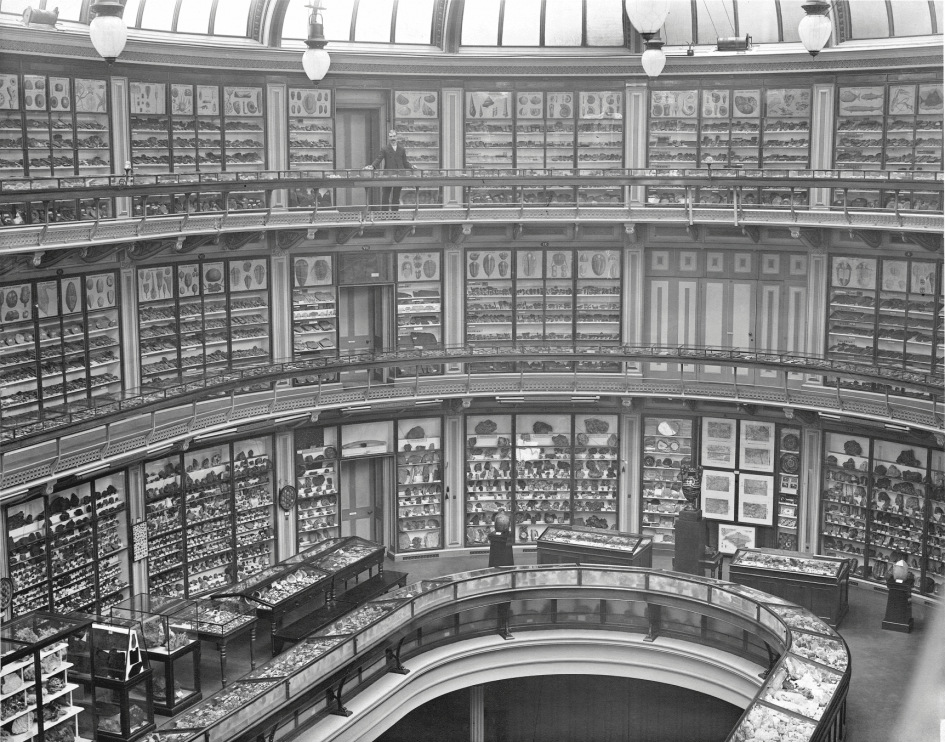
Friday 7 May, 6pm
Organised by the Birkbeck Architecture Space and Society Centre
Mineral Statistics
With Zeynep Çelik Alexander
ASSC’s Thinker in Architecture
The Museum of Economic Geology, founded in London in 1835 and relocated to a custom-designed building between Piccadilly and Jermyn Streets in 1851, consisted not only of exhibition galleries but also the Mining Records Office. This paper examines the role that the Museum played as a proto-database of sorts, connecting the thousands of geological specimens on display in the galleries to the mining records behind them and the world of economic activity beyond.
Zeynep Çelik Alexander is an architectural historian who teaches in the Department of Art History and Archaeology at Columbia University. She is the author of Kinaesthetic Knowing: Aesthetics, Epistemology, Modern Design (2017) and co-editor (with John May) of Design Technics: Archaeologies of Architectural Practice (2020) and (with Daniel Abramson and Michael Osman) Writing Architectural History: Evidence and Narrative in the Twenty-First Century (2021).
New Activist Museums
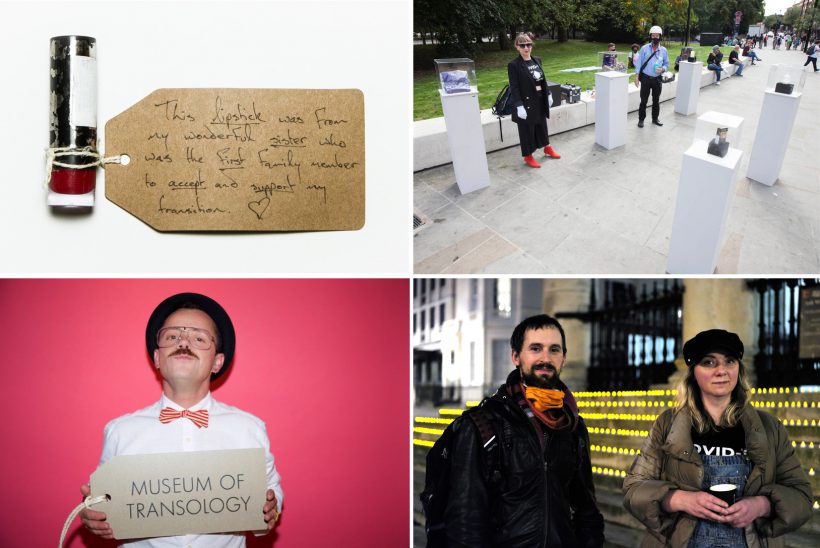
Please join Mapping Museums for an online event featuring the founders of two new activist museums.
Thursday 6 May, 6pm.
How do museums respond to the changing world around them? Featuring the founders of two of these new museums, the Museum of Transology and the Museum of Homelessness, this panel explores the current flowering of museums which focus on social issues. New museums do not always follow established forms and may instead stage temporary exhibitions or pop-up street displays. Listen to a discussion of these new museums and tell us more about your thoughts and ideas on these innovative practices.
Museum of Homelessness is a social justice museum. They carry out events, exhibitions and research that tackle homelessness and housing inequality. They also campaign and carry out direct practical actions. Jess and Matt Turtle founded Museum of Homelessness in 2015.
The Museum of Transology is the UK’s most significant collection of material culture surrounding trans, non-binary and intersex lives. It aims to halt the erasure of trans lives from history by enabling trans people to curate their own stories. The MoT was awarded an Activist Museum Award for 2020–21.
This event is part of Birkbeck’s Arts Weeks 2021.
Introducing the Archive: Discussion Panel
5 March 2021, 18:00-19.30, Online
Stefan Dickers (Special Collections and Archives Manager, Bishopsgate Institute ) and Francesca Hillier (Senior Archivist, British Museum)
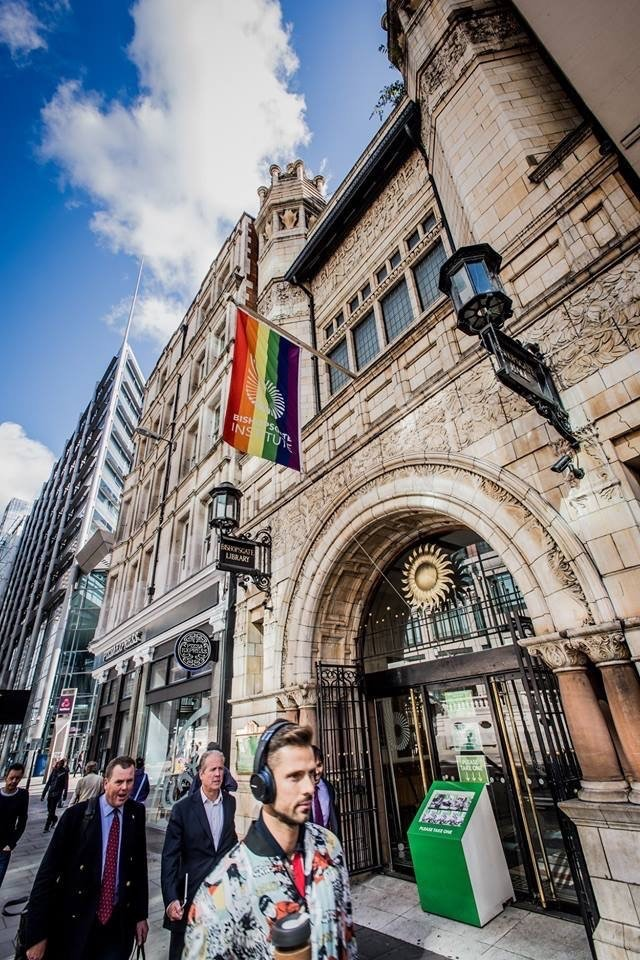

Participate in a discussion panel where Stefan Dickers (Special Collections and Archives Manager, Bishopsgate Institute) and Francesca Hillier (Senior Archivist, British Museum) introduce their collections, and discuss the archives they manage and care for.
Bishopsgate Institute Special Collections and Archives document the experiences of everyday people, and the extraordinary individuals and organisations who have strived for social, political and cultural change. Since the archive opened to the public in 1895 it has been steadily growing, with unique collections gifted and loaned to us. Some are London focused, but the lives they preserve and the issues they explore have national and global resonance. The collections offer both breadth and depth. We have 150,000 books, pamphlets, maps and photographs of London. The Lesbian and Gay News media Archive (LAGNA) alone holds 350,000 press cuttings. The photographic archives over 500,000 images. We have a growing oral-history archive and the collections contain fascinating ephemera, from banners and badges to club flyers and condoms.
The archive of the British Museum relates to the history of the Museum, its collections and its collectors. It is a vast collection, dating from the opening of the Museum in 1753 and covers everything from the building of the first Museum, Montagu House and the election of the first Trustees, to records of past exhibitions and the latest object acquisition. The archive has historically been distributed across the Museum site, and outstations, and has now been brought together under the jurisdiction of the Senior Archivist, with a view to creating a full catalogue of all the archive holdings. The Museum, as a public body, has a legal obligation under the Public Records Act, to make the archive accessible to the public, and part of this requirement includes having an accessible catalogue.
Archive Launch: Mapping Museums
11 February 2021, 18:00, Online (via the Bishopsgate Institute)
Professor Fiona Candlin and Interviewees.
Booking for this event was through the Bishopsgate Institute.
Mapping Museums is a multidisciplinary research project based at Birkbeck, University of London. It has documented and analysed the growth of the UK museum sector from 1960 to 2020 – particularly the emergence of small independent museums.
Enjoy an evening of interviews with the founders of small independent museums, and a glimpse into this archive. Interviewees will include: Steve Allsop (Ingrow Loco Museum and Workshop), Geoff Burton (RAF Ingham Heritage Centre), and Anne Read (Museum of North Craven Life).
Part of the Mapping Museums Project:
Mapping Museums is a multidisciplinary research project based at Birkbeck, University of London. It has documented and analysed the growth of the UK museum sector from 1960 to 2020, paying particular attention to the rising numbers of small independent museums. Over a period of four years the team has compiled information on all the museums that were open in the UK during the period, and has designed a database that allows for that material to be browsed, searched and visualised. They also conducted extensive interview based research to find out how and why people set up their own museums. The recordings, transcripts, and other materials are all available from the Micromuseums Archives at Bishopsgate Institute. For more information see the project website: www.mappingmuseums.org
Navigating Ethical Practice
4 February 2021, 18:00-19.15, Online
Tamsin Russell, Workforce Development Officer, Museums Association
In this workshop, we looked at the Museums Association’s Code of Ethics and how it relates to working in the heritage sector. Working through some ethical situations we developed our professional practice.
Tamsin Russell
Tamsin’s career to date has been on workforce and organisational development and she has worked in both public and private sectors, moving to the cultural sector 20 years ago. Starting as head of training and development for the Science Museum Group, she led the function and implemented new approaches to leadership development. At National Museums Scotland highlights include the development of their Competency Framework. At Historic Environment Scotland her role was in organisational transformation and at National Trust for Scotland she worked on a comprehensive online resource looking at organisational change. Her current role at the Museums Association (MA) looks at workforce in the broadest sense. Providing career workshops, speaking on workforce ethics, equality and wellbeing; as well as leading the MA’s professional development and online learning programmes. In addition to her paid roles Tamsin volunteers for: Museums Galleries Scotland as an accreditation mentor and sits on their Recognition Panel, Arts Council England, sitting on the UK Accreditation Panel, as well as undertaking pro bono and paid freelance work for the sector.
Ars Homo Erotica: Ten Years Later
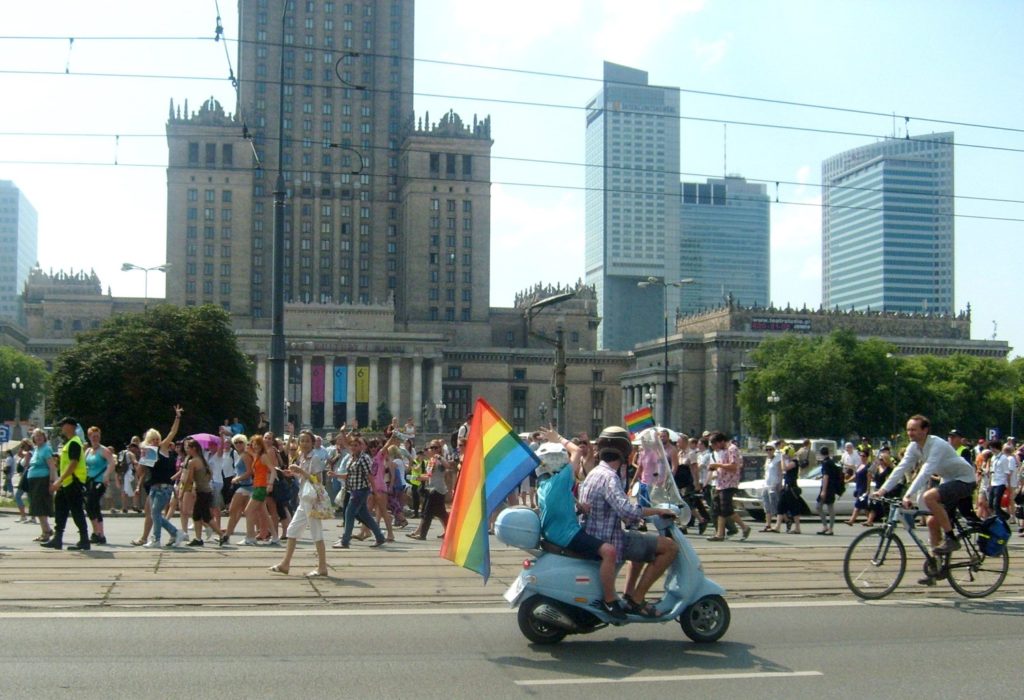
26 November 2020, 18:00 — 20:00,
The event has been recorded and is available here: https://youtu.be/q5SB0PuPLfo
Ars Homo Erotica exhibition opened at The National Museum in Warsaw on 10 June 2010. It examined the significance of homoerotic aesthetic and the homoerotic imagination in the history of art from ancient times until the present. This large-scale show had been devised as the museum’s contribution to the debate on the rights of the LGBTQ communities in Poland, in Eastern Europe, and in the larger world. The idea was proposed by the late Piotr Piotrowski, then the Director of the Warsaw Museum, as a major step of the Critical Museum project, which advocates the use of museum collections and resources to provide forum for debates on burning social and political issues at the time of conflict.
The exhibition was hotly discussed by the media from Poland to Canada, and was vehemently opposed by right-wing politicians in Poland.
This online debate will focus on the impact of the exhibition, which has been listed recently by Maura Reilly as one of the major events of curatorial activism. But, did it help to realign the field?
The event is organised jointly by Birkbeck’s Centre for Museum Cultures; PPV (Perverting the Power Vertical), a research and art platforms based at the FRINGE Centre (UCL SSEES/ Institute for Advanced Studies) and The Courtauld Institute of Art. The event will be recorded and made available after the talk.
Programme:
- Introduction by Katarzyna Murawska-Muthesius, Birkbeck; Michał Murawski, UCL, Maria Mileeva, Courtauld Institute of Art and Denis Maximov (PPV/Avenir Institute)
- Katarzyna Murawska-Muthesius, Ars Homo Erotica – Ten Years Later
- Maura Reilly, Ars Homo Erotica and Curatorial Activism
- Paweł Leszkowicz, The Biggest Curatorial Challenge: Queering the National Museums
- Tomasz Kitliński, Art versus Homophobia – the Polish Case
- Anastasiia Fedorova, Curating Queer Russian Power
- Katarzyna Perlak, presentation of her film Niolam Ja Se Kochaneczke (I once had a lover) 2016, and Happy Ever After
- Q&A
Tomasz Kitliński and Paweł Leszkowicz
Tomasz Kitliński and Paweł Leszkowicz are LGBTQ-feminist activists. Tomasz is Professor of cultural studies at Maria Curie-Skłodowska University in Lublin, Paweł – Professor of Art History at Adam Mickiewicz University in Poznań. They married in Brighton, England.
Tomasz studied with Hélène Cixous and Julia Kristeva, Paweł at the Courtauld Institute of Art, University of London. Tomasz held a post of Fulbright scholar at the Transregional Center for Democratic Studies, New School for Social Research in New York, Pawel was a Fulbright scholar at ONE National Gay & Lesbian Archives at the USC Libraries in Los Angeles. Both of them participated in Eastern Europe’s pioneering lesbian and gay visibility campaign Let Them See Us and, drawing on this experience, authored a Polish-language book Love and Democracy with an extensive English summary. Their other books include: Helen Chadwick: The Iconography of Subjectivity; Naked Man: The Male Nude in post-1945 Polish Art; The Stranger within Ourselves; and Art Pride. They published with Routledge, Palgrave Macmillan, New York University Press, and AICA-Centre Georges Pompidou.
Katarzyna Perlak is a Polish born artist, based in London whose practice employs video, performance, sound and installation. Perlak’s work is driven by politics and feelings; examines queer subjectivities, migration and potentiality of affect as a tool for registering and archiving both present continuous and past historical moments. She currently explores ‘tender crafts’ methodologies and the relationships between notions of utopia, hope, horizon and the concept of the ‘wish landscape’.
Dr Kasia Murawska-Muthesius
Kasia Murawska-Muthesius is a former Deputy Director of the National Museum in Warsaw and an Associate Lecturer at Birkbeck, Department of History of Art. Among her publications are Borders in Art: Revisiting Kunstgeographie (2000); National Museum in Warsaw Guide: Galleries and Study Collections (2001); Kantor was Here: Tadeusz Kantor in Great Britain (Black Dog 2011), From Museum Critique to the Critical Museum (Ashgate 2015, with Piotr Piotrowski), and Maps and Images of Eastern Europe: Sarmatia Europea to Post-Communist Europe (forthcoming with Routledge).
Dr. Maura Reilly is a curator who has organized dozens of exhibitions internationally with a specific focus on marginalized artists. She has written extensively on global contemporary art and curatorial practice, including, most recently Curatorial Activism: Towards an Ethics of Curating (Thames & Hudson, 2018), which was named a “Top 10 Best Art Book of 2018” by the New York Times. Reilly is the Founding Curator of the Elizabeth A. Sackler Center for Feminist Art at the Brooklyn Museum, where she developed and launched the first exhibition and public programming space in the USA devoted entirely to feminist art. While there, she organized several landmark exhibitions, including the permanent installation of Judy Chicago’s The Dinner Party, the blockbuster Global Feminisms (co-curated with Linda Nochlin), among many others. She is a founding member of two initiatives dedicated to fighting discrimination against women in the art world – The Feminist Art Project (TFAP) and Feminist Curators United (FcU). In 2015, Reilly was named one of the Top 50 most influential people in the art world by Art & Auction, in recognition of her advocacy for women artists. She received her M.A. and PhD in art history from the Institute of Fine Arts, New York University, and is an Editor-at-Large for the Brooklyn Rail. Reilly is Associate Professor of Art History and Museum Studies at Arizona State University.
Provenance matters: Interwar acquisitions of Venetian Renaissance art in Northern Europe between the Wars

Wednesday 18 November, 4.50pm for 5pm
Sarah Ferrari
This paper aims to shed new light on the dynamics of the European art market between the First and Second World War by investigating a group of paintings acquired by the Nationalmuseum in Stockholm, Sweden, between 1917 and 1954. This group includes works attributed to Jacopo Tintoretto, Titian, Andrea Schiavone and Paolo Veronese, some of which were once part of the celebrated collection of Queen Christina of Sweden (1626-1689). As part of a joint project dedicated to the collection of Italian paintings of the Nationalmuseum, this research aims to offer a detailed account of both documentary sources, and material aspects. Furthermore, it will bring new information on the network of collectors and dealers involved (Julius Böhler in Munich, Adolph Thiem in Sanremo and Berlin, Axel Beskow in Sweden and the US), while at the same time analyzing the role of national identity as a driving force in the context of these acquisitions.
This event is part of the ongoing series of Murray Seminars at Birkbeck.
Leonardo 500: Studying, Visualising and Displaying Drawings and Manuscripts
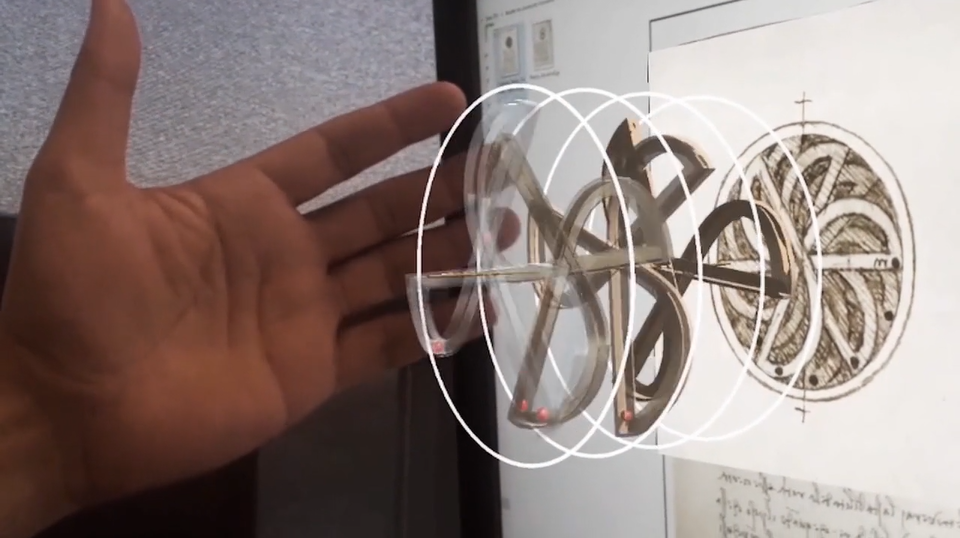
Juliana Barone
5 November 2020, 18:00— 19.15, Online
Leonardo da Vinci is one of the world’s best-known pre-twentieth-century artists. Much has been written about him and scholarly and imaginative works line the shelves of bookshops, and of institutional and private libraries. His portable paintings have sold in the multi-millions; some have been stolen and retrieved, others lost or mistakenly attributed, others still have not changed hands since the seventeenth century. However, Leonardo’s written legacy and the incredible variety of drawings that are found in his notebooks remain largely unknown. The breath of his investigations, the richness of his drawing techniques and, above all, the singularity of his work methods raise complex issues of interpretation and display. Traditional forms of study and visual engagement fail to do justice to the extraordinary fertility, spontaneity and rapidity of his mind and hand. This seminar paper aims to discuss some of the ways in which digital technology is now being used to address the challenges of his written and drawn legacy. Particular attention will be paid to a number of selected examples from exhibitions marking the 500th anniversary of Leonardo’s death that I have recently curated in London and Florence, and which have involved the collaboration of institutions such as the British Library, the Peltz Gallery, the Vasari Centre for Art and Technology, Ravensbourne College, and the Museo Galileo.
Juliana Barone was awarded her Doctorate at Trinity College (Oxford University), had a Junior Research Fellowship (JRF) at St John’s College (Oxford University) and is Honorary Research Fellow in the Department of History of Art at Birkbeck College (University of London). She has published extensively on Leonardo da Vinci, her main books including: Leonardo: the Codex Arundel (2008); I disegni di Leonardo da Vinci e della sua cerchia. Collezioni in Gran Bretagna (with M. Kemp, 2010); Leonardo in Seventeenth-Century France: Paradoxical Legacies (2013) and Leonardo in Britain: Collections and Historical Reception (with S. Avery-Quash, 2019). Juliana has also curated exhibitions in London, Milan and Florence. Most recently, she was Associate Curator of the exhibition ‘Leonardo da Vinci: a mind in motion’ at the British Library in London (2019); and co-curator of the London exhibition ‘Leonardo da Vinci and Perpetual Motion: Visualising Impossible Machines’ at the Peltz Gallery (2019), as well as of the Florence exhibition ‘Leonardo da Vinci and Perpetual Motion’ at the Museo Galileo (2019).
Trophies of empire: exotic props in two paintings by John Everett Millais
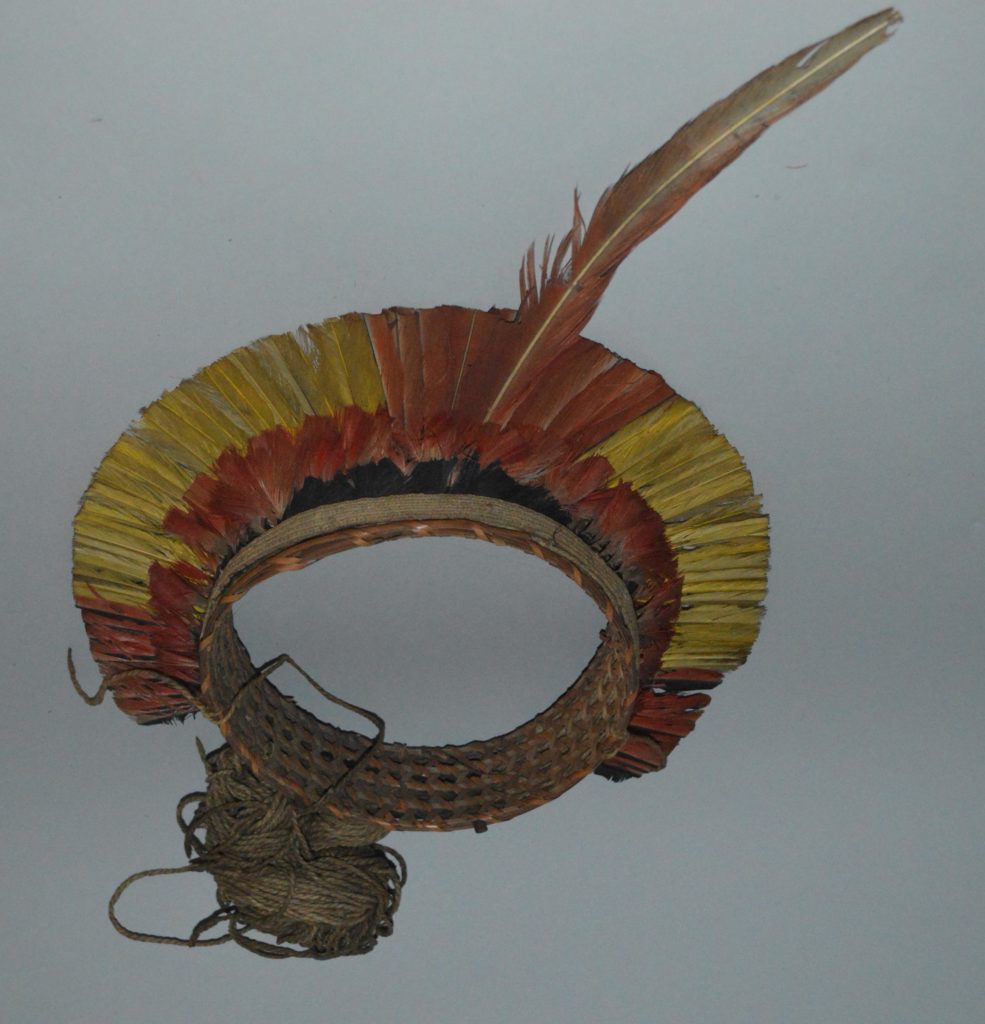
Ian Dudley
18 November 2020, 18:00— 19.15, Online
This talk focuses on unexamined links between the artists John Everett Millais (1829–96) and Edward Angelo Goodall (1819–1908). It describes how a range of Indigenous artworks collected by Goodall while working as the illustrator of a colonial boundary survey of British Guiana during the 1840s became the basis for two Millais paintings: Pizarro Seizing the Inca of Peru (1846) and The Boyhood of Raleigh (1870). Close object identifications using written and pictorial expedition sources combined with anthropological literature and British Museum collection records, highlight connections between Millais’s production and histories of British colonialism in the Guayana region. Particular attention will be paid to a featherwork headdress, which appears in both paintings, but has often been misidentified as a basket in The Boyhood of Raleigh, and consequently not recognized as the same object used for the Inca imperial crown in the earlier work. These visible and material connections will be considered in relation to Ralegh’s fantastical writings, which linked Guayana to Peru via El Dorado mythology, and informed his historiographic reconstruction as an icon of British imperialist masculinity during the 1840s-60s.
Ian Dudley is a Lecturer in Art History at Birkbeck and a Visiting Fellow at the University of Essex. His research focuses on relationships between histories of art and empire from the early modern period to the present. Recent work includes a study of Olmec colossal heads in the paintings of Aubrey Williams, published in Art History, and an examination of slavery visualisation in the sculpture of Stanley Greaves, forthcoming in Third Text. His 2017 doctoral thesis investigated Edward Goodall’s Sketches in British Guiana within the context of colonial geography and anthropology during the 1830-40s.
Come Hell or High Water: Managing Disasters in Museums
Thursday 25 June 6–7.15pm, Live Online
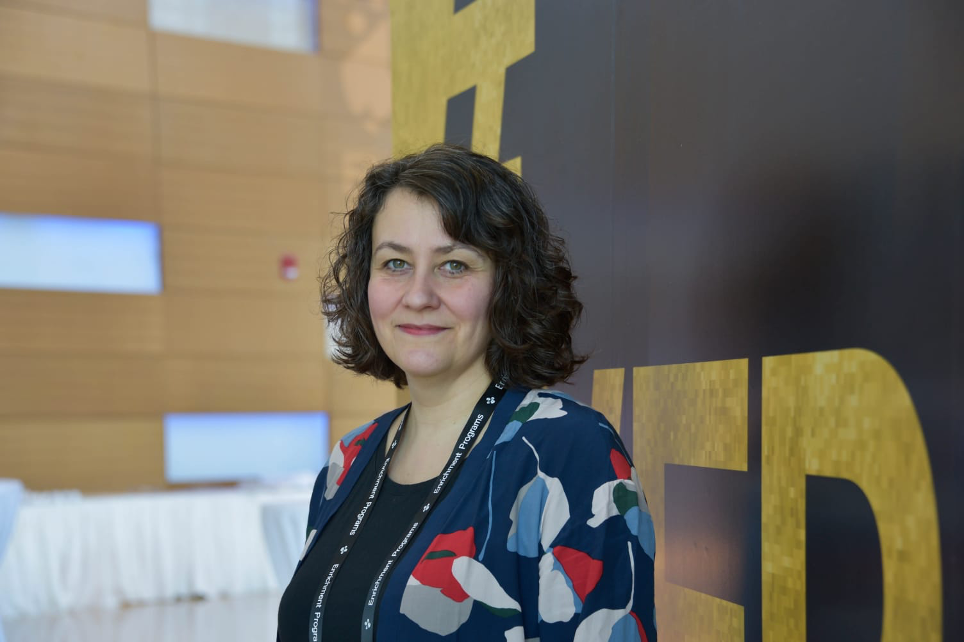
As museum professionals face the unprecedented challenge of caring for their collections during the global crisis of Covid-19, they possess one advantage – they often have previous experience of battling with disasters on a much smaller scale as part of their ordinary working life. Water leaks or pest infestations that might be unfortunate in a domestic setting can reach disastrous heights when applied to precious heritage collections and the fragile buildings that house them. Careful disaster planning can go some way to mitigate risk, but the unexpected can and does happen, often at the most inconvenient times. Times of crisis require very different styles of management to everyday museum life, and especially in smaller museums, curators and directors are required to develop new leadership skills under intense pressure. In this talk, Keeper of Medicine at the Science Museum Natasha McEnroe will share a personal reflection of her own working life in different museums, and the variety of disasters she has flinchingly faced, from rats to raw sewage.
Natasha McEnroe is the Keeper of Medicine at the Science Museum in South Kensington, London. Her previous post was Director of the Florence Nightingale Museum, and prior to this she was Museum Manager of the Grant Museum of Zoology and Comparative Anatomy and Curator of the Galton Collection at University College London. From 1997 – 2007, she was Curator of Dr Johnson’s House in London’s Fleet Street, and has also worked for the National Trust and the Victoria & Albert Museum. Natasha was editor of Medicine: An Imperfect Science (Scala, 2019), co-editor of The Medicine Cabinet (Carlton, 2019) and co-editor of The Hospital in the Oatfield – The Art of Nursing in the First World War (Strange Attractor, 2014). Her research interests focus on 19th-century public health and the history of nursing. She is a Trustee of Dr Johnson’s House in London and of the Erasmus Darwin Museum in Lichfield and is a Freeman of The Worshipful Company of Barbers. Natasha also sits on the National Accreditation Committee for Arts Council England.
Blast Theory: Reflections on Contagion, Cities and Decision Making in Public Health Crises
Tuesday 30 June, 6–7.30pm (Online)
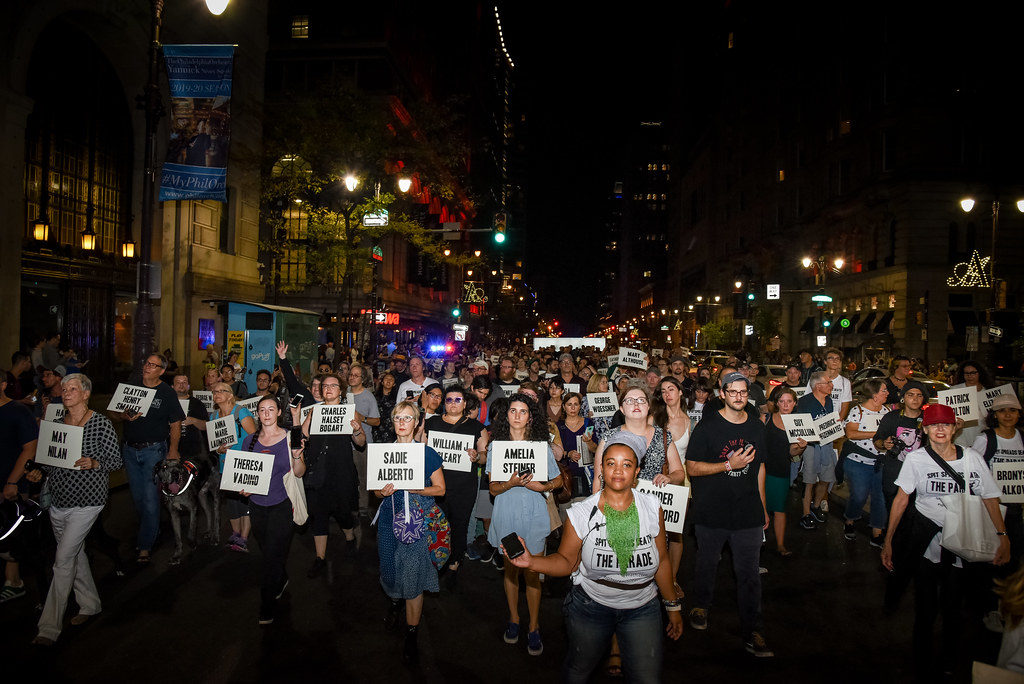
You can watch the recorded event, here
Led by artists Matt Adams, Ju Row Farr and Nick Tandavanitj, Blast Theory draw on popular culture, performance, technology and games, the work often blurring the boundaries between the real and the fictional. In 2018 they were the first ever artists-in-residence at the World Health Organisation (WHO). They spent time at WHO’s Strategic Health Operations Centre, which monitors epidemics and pandemics across the world and coordinates international collaborative responses. The work prompted by their residency reflects on contagion and cities, and focuses on moments of uncertainty in public health decision making and the 2003 SARS epidemic. A Cluster of 17 Cases, was inspired by the story of 17 unsuspecting people who stayed on the 9th floor of a Hong Kong hotel on the night of Feb 21, 2003. These 17 people were subsequently identified as spreading the SARS virus to at least 546 people around the globe. Blast Theory’s work on infectious disease continued last year with Spit Spreads Death, an interactive parade of light and sound designed to remember the individuals who lost their lives and the health workers who put their own lives on the line in Philadelphia in 1918–19, when more than 12,000 people died in the deadliest flu pandemic the world has ever seen.
Birkbeck’s Centre for Museum Cultures and Centre for Medical Humanities are delighted to present a live, online event during which Blast Theory will discuss their recent work and its implications for the current Covid-19 crisis. An open Q&A will follow the artists’ talk and panel discussion.
Museums in Wartime
Thursday 2 July 6–7.30pm (Online)
A live online panel with three curators discussing how their institutions have responded to crisis during wartime, and what lessons might be learned by museums today.
Picturing Crisis: Historic England’s crowdsourced photographic collections
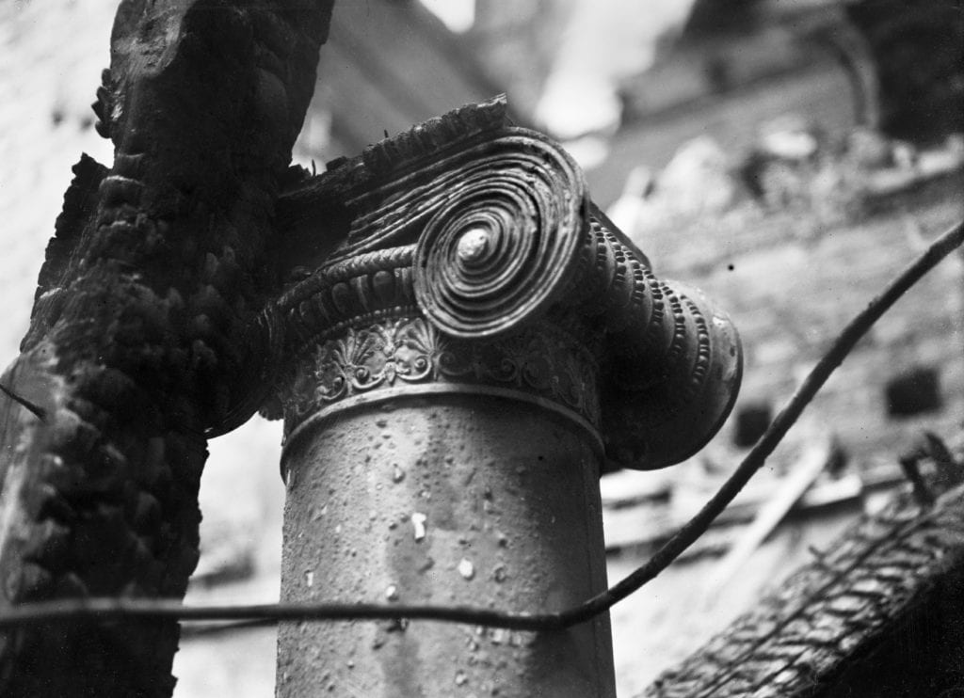
In response to the Covid-19 lockdown, for the first time since the Second World War Historic England asked the public to capture a moment in time for the Historic England Archive, the nation’s archive for records of England’s historic buildings, archaeology and social history. The Picturing Lockdown project created a visual record of this extraordinary moment. It was inspired by the National Buildings Record (NBR), a Second World War public call out for voluntary help in contributing records of the nation’s heritage under threat. NBR photographs created the nation’s archive for buildings that were lost during the Blitz and featured in IWM’s 2019 Culture under Attack season. As Historic England explores opportunities to share the Picturing Lockdown collection, its curator Tamsin Silvey will discuss why public engagement is at the frontline of protecting heritage during times of crisis.
Since 2015 Tamsin Silvey has been Cultural Programme Curator at Historic England, the public body that helps people care for, enjoy and celebrate England’s historic environment. She initiated Picturing Lockdown and co-curated What Remains, one of the exhibitions in IWM’s Culture Under Attack season, exploring the destruction of culture and heritage during conflict. She specialises in curating and managing photographic projects, and is a PhD researcher at Birkbeck interrogating how conflict photographs have been curated within temporary exhibitions at British institutions from 2010-20.
Choosing what to Protect: The V&A during World War I and World War II
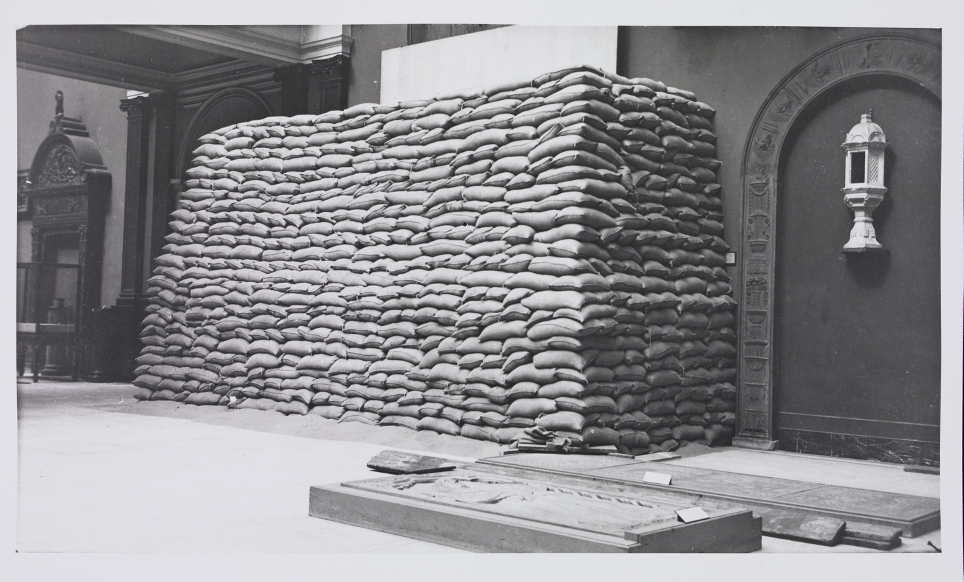
It is sometimes thought that when an object enters a museum, it enters stasis and its narrative ends. However, some of our objects have led surprisingly exciting lives within the Museum. During both World Wars the V&A selected a range of its most precious treasures and hid them for safety in a bewildering array of places. Curator Ella Ravilious will explain some of the decision-making behind which objects got protected, where and why, and what happened to them during that time and directly afterwards – in particular, how post-war museum practices led to a dramatic object theft. She will also explore the surviving contemporary narratives from staff about what the museum experience was like during wartime.
Ella Ravilious is a curator in the Word and Image Department at the V&A. She manages a cataloguing and digitisation project for that Department, as well as having a role in disaster planning for the wider V&A collections. She is also a current PhD student at the Photographic History Research Institute at De Montfort University, studying the history and provenance of the V&A’s Photography Collection.
Keeping Culture Alive: the National Gallery during World War II
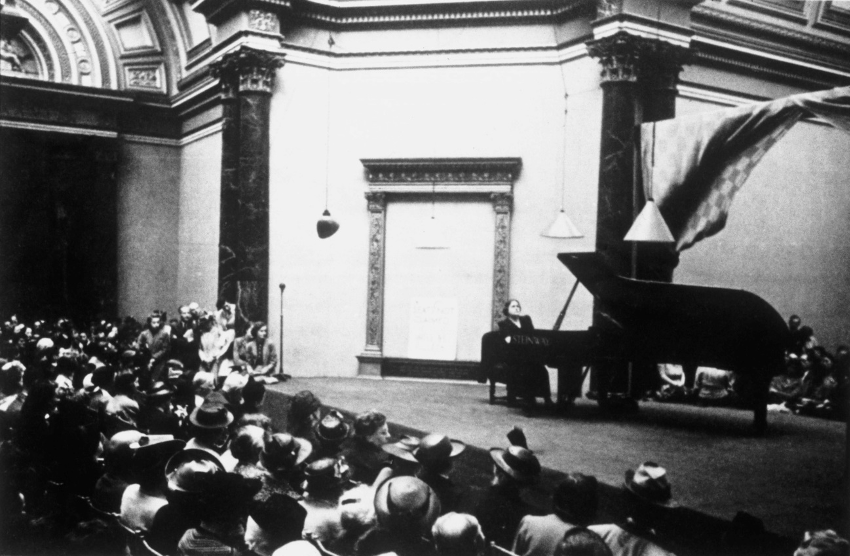
The National Gallery is currently unable to give visitors access to the pictures physically due to the Corona pandemic, however, through digital technology people are still getting the chance to treasure great art. History shows that the Gallery has weathered other national emergencies, the most dramatic of which was the Second World War. During that conflict the Gallery, despite many of its galleries being bomb-damaged, was one in fact of the few places in London where the public could enjoy a programme of cultural activity. Drawing on visual and written records from the Gallery’s archives, this talk will discuss the range of events put on at Trafalgar Square, the motivations behind these activities, the impact they had at the time, and lessons we may learn from them today. The first form of cultural entertainment were the lunchtime concerts organised by Myra Hess which made classical music accessible; exhibitions followed ranging from contemporary war art and one-off shows like ‘Design at Home’ to the much-loved ‘Picture of the Month’ that brought back a series of paintings from the Gallery’s permanent collection from storage in a Welsh mine.
Susanna Avery-Quash, Ph.D., F.S.A, is Senior Research Curator (History of Collecting) at the National Gallery, London, where she is in charge of the research strand ‘Buying, Collecting and Display’. Her research focuses on important private and public art collections — especially the National Gallery — trends in artistic taste, and the historical art market. She has published extensively on Sir Charles Eastlake, first director of the National Gallery; John Julius Angerstein, paintings from whose collection formed as the nucleus of the Gallery; and on the reception, collecting, and display of Italian art in Britain. She has recently co-edited The Georgian London Town House: Building, Collecting and Display (with Kate Retford, 2019), London and the Emergence of a European Art Market, 1780–1820 (with Christian Huemer, 2019), Leonardo in Britain: Collections and Historical Reception (with Juliana Barone, 2019), and co-edited ‘Old Masters, Modern Women’, a special issue of 19: Interdisciplinary Studies in the Long Nineteenth Century (Issue 28 – 2019) with Hilary Fraser and Maria Alambritis.
Time-based media in the museum: conserving and activating performance
Bergit Arends, University of Bristol, and Louise Lawson, Tate
Thursday 6 February, 6–7.30pm
Keynes Library, 43 Gordon Square
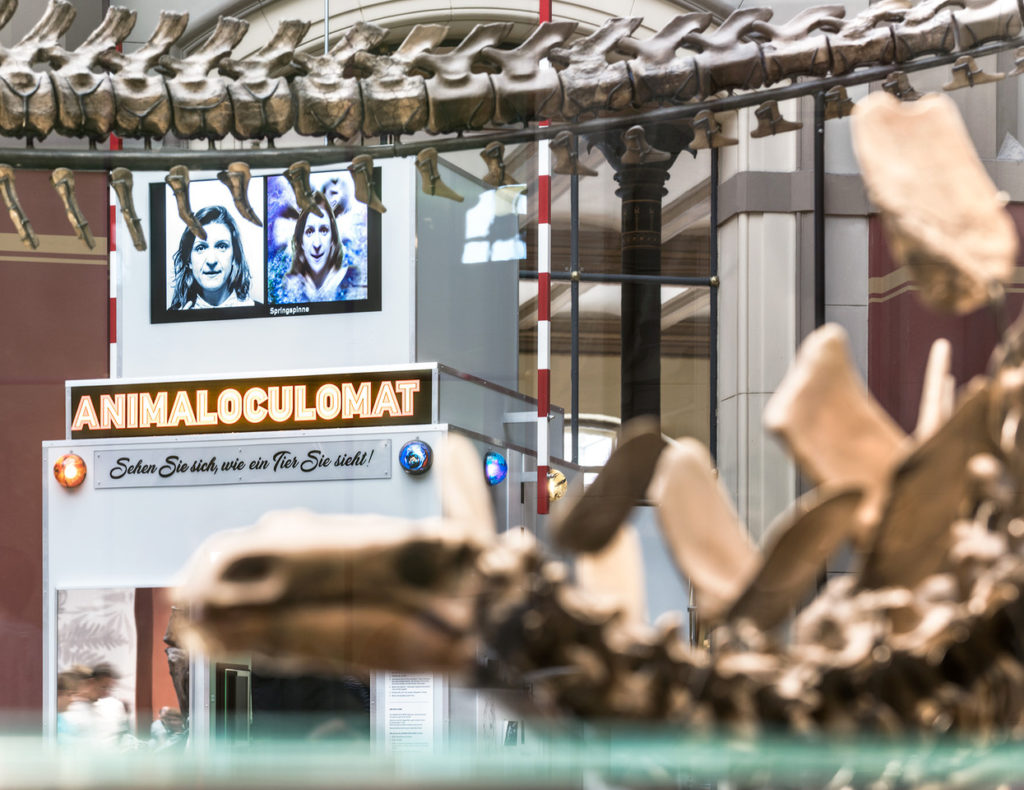
Photo: Carola Radke.
The joint talk offers insights into collections of performance art at Tate and the performance of historic collections by contemporary artists at natural history museums. We discuss the processes of archiving, conservation and activation of works. We will consider the durability of materials, their decay and continuing issues of conservation. We consider different archival and collecting structures as well as the interactions of time-based media and photography within and beyond the museum.
Bergit Arends is a curator and researcher, creating and studying interdisciplinary curatorial and artistic processes, currently focusing on environment and visual art. She has published in Interdisciplinary Science Reviews, Botanical drift: protagonists of the invasive herbarium (Sternberg Press, 2018), on decolonising natural history museums (Routledge, forthcoming), and on plants in artistic practices (Jovis, forthcoming).
Her thesis Contemporary Art, Archives and Environmental Change in the Age of the Anthropocene (2017)resulted among other in the award-winning publication Chrystel Lebas. Field studies: walking through landscapes and archives (Fw:Books, 2018). She curated many contemporary art projects for the natural history museums in London and Berlin (Kunst/Natur, Braus, 2019). Most recently, Bergit was in Collection Care Research at Tate. She is now British Academy Postdoctoral Fellow in the Department of History of Art at University of Bristol.
Louise Lawson is Conservation Manager for Time Based Media Conservation at Tate. She is responsible for the strategic direction, development and delivery of all aspects relating to time-based media conservation at Tate. This requires working across a wide range of projects and programmes: exhibitions, displays, acquisition, loan-outs and collection care initiatives such as the development of a digital repository. Her areas of interest and research are focussed on the replication, enactment and activation of artworks and working in collaboration with artists and artist estates. Her research is on performance-based artworks within Tate Collection.
Decolonizing the Monument / Rethinking the Memorial
Annie E. Coombes, Birkbeck, University of London
6 February, 15:00 – 17:00, Room 509, Manne Siegbahn Buildings, Frescativägen 26, Stockholm University
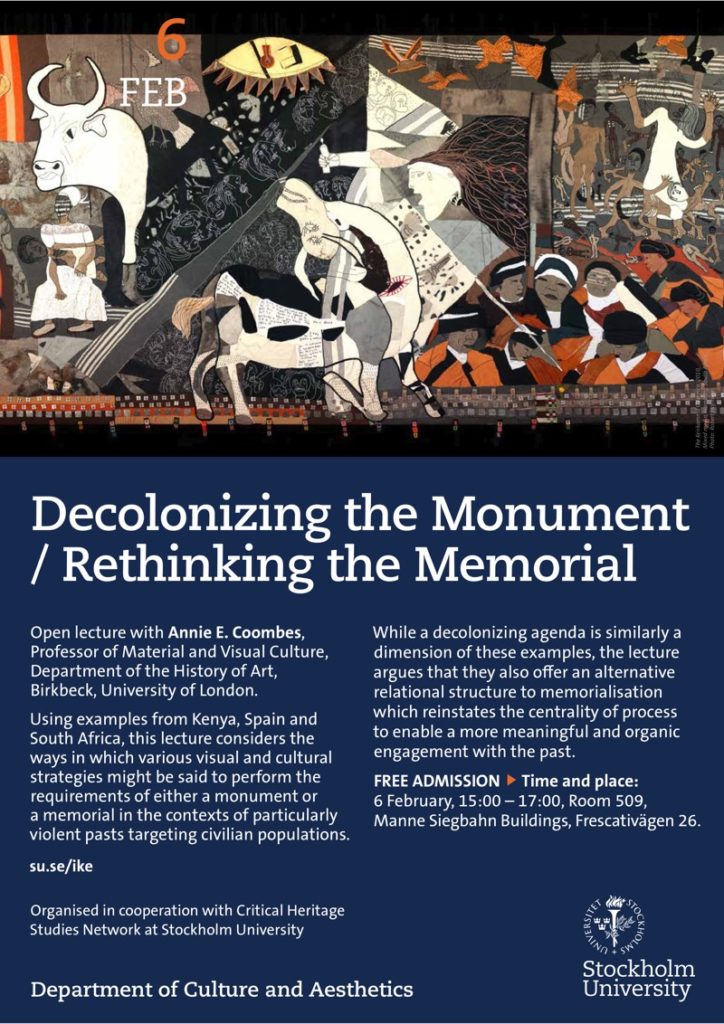
Open lecture with Annie E. Coombes, Professor of Material and Visual Culture, Department of the History of Art, Birkbeck, University of London.
Using examples from Kenya, Spain and South Africa, this lecture considers the ways in which various visual and cultural strategies might be said to perform the requirements of either a monument or a memorial in the contexts of particularly violent pasts targeting civilian populations.
While a decolonizing agenda is similarly a dimension of these examples, the lecture argues that they also offer an alternative relational structure to memorialisation which reinstates the centrality of process to enable a more meaningful and organic engagement with the past.
Concealed Histories: Uncovering the Story of Nazi Looting
Jacques Schuhmacher, V&A
Friday 13 December, 5–7pm
Victoria & Albert Museum
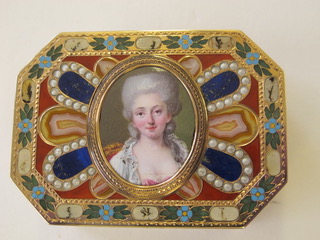
Join the V&A’s Provenance Curator on a behind-the-scenes tour of the special display ‘Concealed Histories’, which uncovers the history behind several fascinating objects of incredible craftsmanship that take us to the heart of the Nazis’ looting of art across Europe. Learn about the V&A’s efforts to identify objects in its care which were sold under duress or stolen under Nazi rule so that they can be returned to the families of the victims. The tour will shine a light on the difficult task of communicating this complex and deeply unsettling research to visitors from around the globe.
Jacques Schuhmacher is the Provenance and Spoliation Curator at the Victoria & Albert Museum. He is a historian of Nazi Germany and the Second World War and holds a PhD from the University of Oxford.
The Critical Museum Debate Continues
Katarzyna Murawska-Muthesius, Birkbeck
Monday 11 November, 6–7.30pm
Keynes Library, 43 Gordon Square
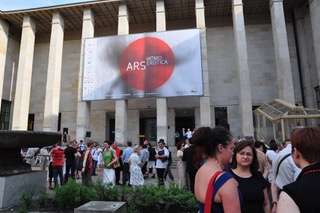
The project of the Critical Museum – the art institution which uses its own resources, including its collection, its range of activities and its “auratic” space, for encouraging and hosting the debates on the issues that are crucial for contemporary societies – was one of the boldest and socially most significant battles undertaken by Piotr Piotrowski, when invited to run the National Museum in Warsaw in 2009. The Critical Museum project, underscored by the transnational attitude of the engaged intellectual, formed part and parcel of Piotrowski’s long-standing campaign against the prevalent discourses of contemporary art history and, in particular, against the hierarchical artistic geography, eulogising masterpieces, and marginalising the arts of East Central Europe. However, it was not just the art historical canon which was the target. Piotrowski’s museum was devised, first and foremost, as a forum, as an active agent in the public sphere, the venue for exhibiting art and discussing society, deliberately contributing to the process of defending democracy and its values, digging up difficult memories, juxtaposing conflicting narratives, empowering the disempowered, with a special attention given to the rights of minorities. The programme led to a seismic shake-up, far beyond the corridors of Polish museums. As stressed by Piotrowski, the realisation of the Critical Museum model was not only the most desirable, but indeed solely possible outside the realm of the West, in East Central Europe. Although the project was aborted, the field has been realigned and the discussion about the Critical Museums continues. The paper will discuss the origins and the premises, as well as the aftermath of the Critical Museum project.
Dr Katarzyna Murawska-Muthesius teaches art history at Birkbeck College, University of London. Before her arrival in the UK in 1993, she was Curator of Italian Paintings (1981-90) and Chief Curator of The National Museum in Warsaw (1992-93). She returned as its Deputy Director in 2009-11. Recipient of the Henry Moore Institute Research Fellowship, and the Leverhulme Trust Research Fellowship, she lectured in various universities and art institutions in Europe and the US, including Institut für Kunst- und Bildgeschichte at the Humboldt Universität Berlin: she was Guest-Professor there in 2009, and Rudolf-Arnheim Professor in 2013/14. Her publications include: Europäische Malerei aus dem Nationalmuseum Warschau (Braunschweig 1988); Trionfo barocco (Gorizia 1990); Borders in Art: Revisiting Kunstgeographie (Warsaw 2000); National Museum in WarsawGuide: Galleries and Study Collections (Warsaw 2001, with Dorota Folga-Januszewska); Jan Matejko’s “Battle of Grunwald”: New Approaches (Warsaw 2010); Kantor was Here: Tadeusz Kantor in Great Britain (London 2011, with Natalia Zarzecka), From Museum Critique to the Critical Museum (Farnham, Ashgate 2015, Routledge 2017), co-edited with Piotr Piotrowski. Her current research is on imaging Eastern Europe.
Curating Secret Rivers
Thomas Ardill, Museum of London
Monday 21st October, 6pm
Keynes Library, 43 Gordon Square
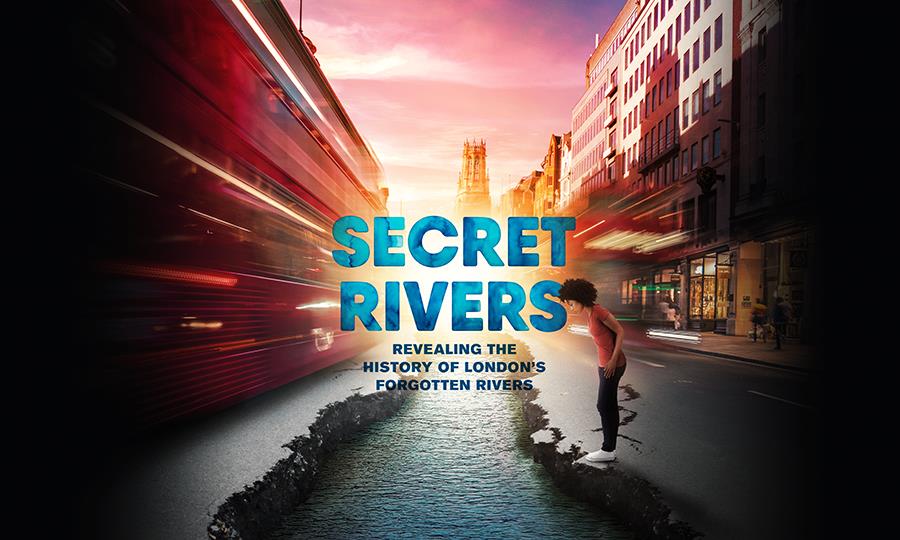
In this illustrated talk, Thomas Ardill will discuss co-curating the Secret Rivers exhibition at Museum of London Docklands. Thomas will explain the Museum of London’s exhibition-making process from programming to design and installation, and reflect on the experience of co-curating with an archaeological curator including the collaborative process, the challenges of putting on a multimedia display and what he has learned by curating an art collection in a social history museum.
Dr Thomas Ardill joined the Museum of London in 2016 as Curator of Paintings, Prints and Drawings having previously worked at the National Portrait Gallery and Tate Britain. In addition to co-curating Secret Rivers, he has curated displays on the relationship between art and charity in William Macduff’s painting Shaftesbury, or Lost and Found, 1862, and a competition and display of night photography in London (Dark Corners, 2018). He has undertaken extensive upgrading of the Museum’s art collection records and is currently working with Kate Sumnall and other colleagues on future displays at the Museum of London’s new site at West Smithfield.
Decolonising the Monument / Rethinking the Memorial
Professor Annie E Coombes
15 October 2019
University of Plymouth
As a counterpoint to the rise of the nationalist right (again) in Europe, the United States and elsewhere in the world, there has been an increased demand on many university campuses, for institutions to address colonial amnesia and to actively decolonize the curriculum.
Public statues were also key components of this process, particularly the removal of monuments dedicated to the “heroes” of the colonial period. Using examples from Kenya, Spain and South Africa, this lecture considers the ways in which violent pasts targeting civilian populations can be remembered today. It also investigates alternative forms of collective memory which enables a shared and more organic engagement with history.
Professor Annie E Coombes is Founding Director of the Peltz Gallery and Professor of Material and Visual Culture in the Department of Art History at Birkbeck, University of London. She is a cultural historian specialising in the history and culture of British colonialism and its legacy in the present, particularly in Africa. Annie has produced key publications that investigate contemporary state and community-led memorial projects and museum approaches to difficult histories, including: History After Apartheid: Visual Culture and Public Memory in a Democratic South Africa (2003) and Managing Heritage, Making Peace: History, Identity and Memory in Contemporary Kenya (with L Hughes and Karega-Munene) (2013).
More details: https://www.plymouth.ac.uk/whats-on/talk-decolonising-the-monument-rethinking-the-memorial
Tuesday 25 June 2019, 14:30-17:00
Reanimating collections, sharing knowledges
Room G03, 43 Gordon Square, London WC1H 0PD

How can archives and collections be more openly available to indigenous researchers? What are the potentialities and drawbacks of digital knowledge bases? What is the role of historic collections to contemporary indigenous peoples? How can indigenous knowledge be displayed on a par with scientific knowledge?
This round-table brings together European and Brazilian researchers and curators, including indigenous researchers, to discuss ways of advancing co-curatorship on Latin American collections in European archives and museums.
Speakers include: Andrea Scholz (Ethnological Museum Berlin), Mariana Françozo (Leiden University), Nildo Fontes (FOIRN, Federation of the Indigenous Organizations of Rio Negro), Aloisio Cabalzar (ISA, Socio-environmental Institute), William Milliken (Royal Botanic Gardens, Kew), Mark Nesbitt (Royal Botanic Gardens, Kew), Viviane Kruel (Rio de Janeiro Botanic Garden), João Pacheco (National Museum, Rio de Janeiro), Laura Osorio Sunnucks (British Museum).
Chair: Luciana Martins (Birkbeck)
14:30 – 14:40 Introduction
14:40 – 15:40 Short presentations
15:40 – 16:00 Coffee break
16:00 – 17:00 Discussion
This round-table forms part of the research project ‘Digital repatriation of biocultural collections: connecting scientific and indigenous communities of knowledge in Amazonia’, funded by a British Academy Knowledge Frontiers award.
This event is free and open to all. Postgraduate students are particularly welcome.
This event is jointly organised with CILAVS.
Friday 7 June 2019
Small Museums in a Global Context
Keynes Library, School of Arts, 43 Gordon Square
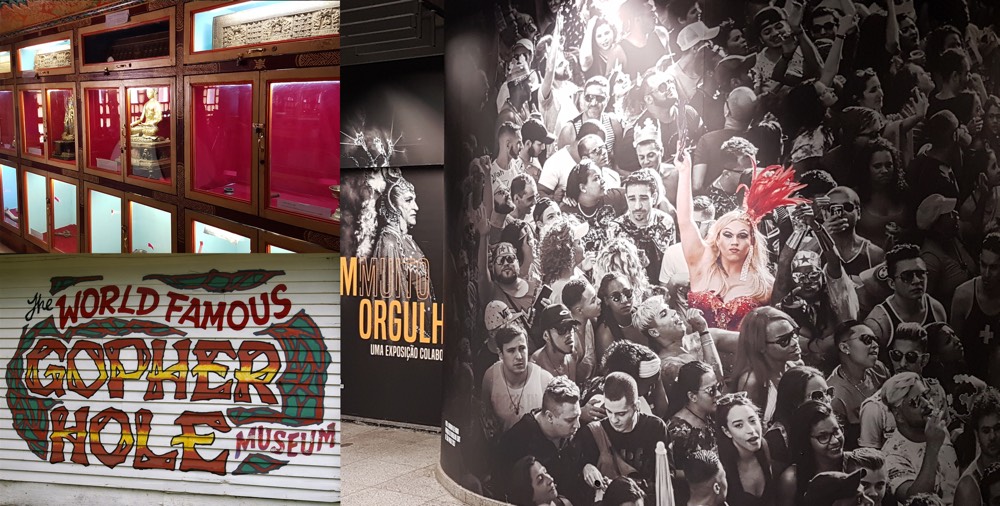
During the late twentieth century there was a massive rise in the numbers of museums across the world. In the main, these new museums were small, independent and addressed non-traditional subjects. However, very little is known about the differences and commonalities in museum development in a global context. In this half-day symposium, specialists on Brazilian, British, Canadian, Tibetan, and Kenyan museums will explore the various factors that underpinned museum expansion in specific countries or regions. We will ask: what forms did the new museums take, who founded them, for what reasons, and with what effects?
Speakers
Lianne McTavish: From Gophers to Fear and Wonder: Studying the Small Town and Rural Museums in Alberta, Canada
Louise Tythacott: The Buddhist Museums Boom
Bruno Brulon Soares: Community museums of the 21st century in Brazil: local experiences for a global reflection
Fiona Candlin: Village Life, the Cold War, and the Beeching Cuts: Opening museums in the UK
To be followed by a round-table discussion.
Chair: Annie Coombes
Full details including abstracts and speaker bios
Tuesday 28th May
What is a Museum? (And how would we know?)
Professor Fiona Candlin (Inaugural lecture)
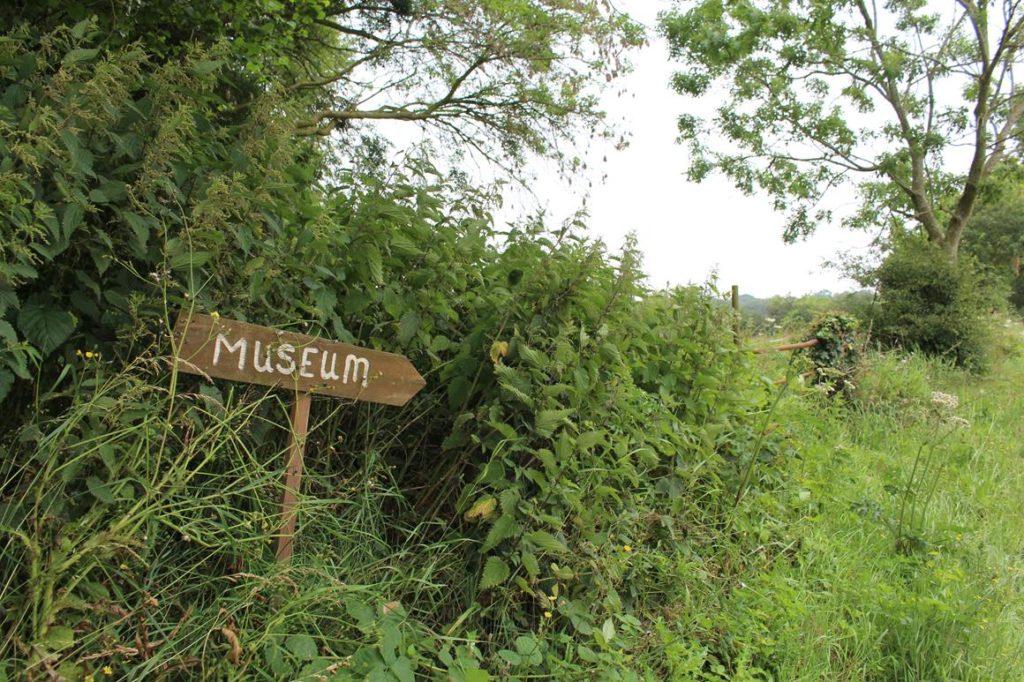
The Mapping Museums project aims at analysing development and change within the UK museum sector from 1960 until the present day. In order to achieve that ambition, the research team has had to compile a dataset of all the museums open during that period. Doing so led us to ask what kinds of organisations should be included and how we should make that decision. Should we include heritage and visitor centres, historic houses and other buildings, or the exhibitions in hospitals, town halls, and corporate headquarters? What about galleries without collections or museums that are only open for five days per year? Should we draw the line between private collections and private museums, and if so, where and how? In her inaugural lecture Professor Fiona Candlin, Principal Investigator on the Mapping Museum project, outlines the various approaches that the team adopted (and mainly abandoned) in their pursuit of a coherent selection strategy.
Fiona Candlin is Professor of Museology within the History of Art department at Birkbeck College, University of London. She is the Principal Investigator on a large scale research project entitled ‘Mapping Museums: The history and geography of the UK independent sector 1960-2020’. In this capacity she collaborates with Alex Poulovassilis, Professor of Computer Science at Birkbeck. They lead an interdisciplinary research team that is collectively documenting, visualising, and analysing the recent development of the UK museum sector.
Candlin also collaborates with the Bishopsgate Institute on the ‘Micromuseums Archive’, and has published widely on various aspects of museums, particularly on the history, curation, and architecture of small independent museums. She co-edited The Object Reader (Routledge 2009) with Raiford Guins, and is the author of Art, Museums, and Touch (Manchester 2010) and Micromuseology: An analysis of small independent museums (Bloomsbury 2015). Her current writing retains an emphasis on grass roots venues and additionally focuses on definitions of museums and data collection within the museum sector.
Thursday 23rd May 2019
Patrons and Lovers of Art: Art Institutions, collecting and the wealth of empire in early nineteenth century London
Sarah Thomas, Catherine Roach, Susanna Avery-Quash, Kate Retford (Chair)
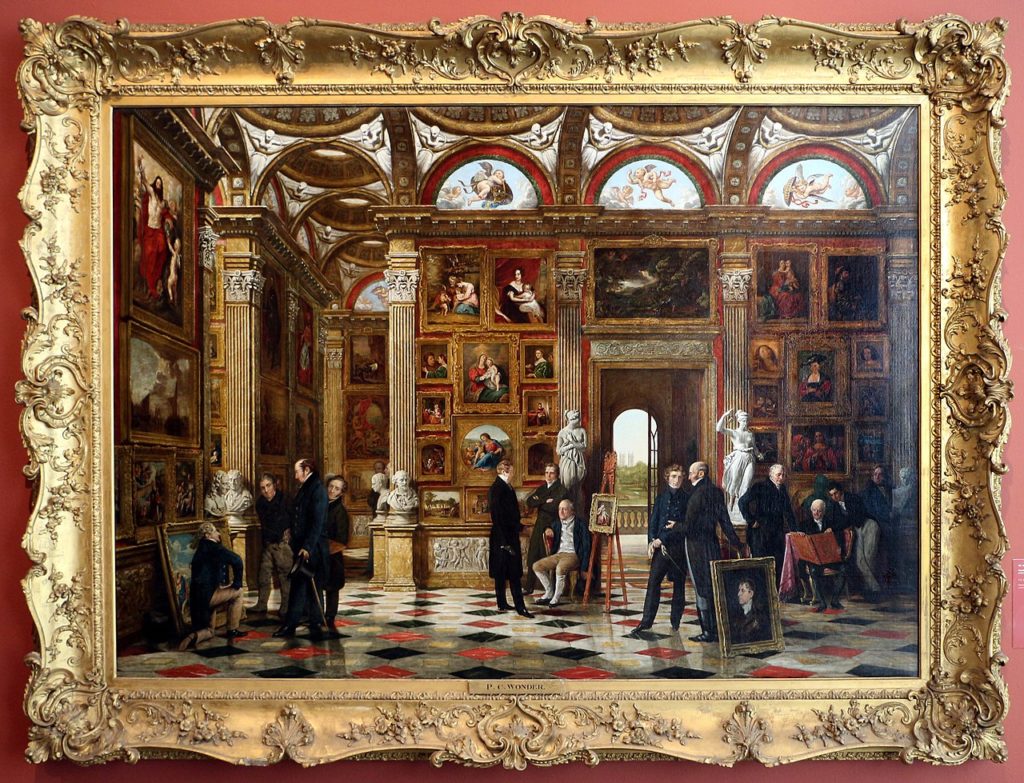
Pieter Christoffel Wonder, Patrons and Lovers of Art (1830), private collection
The foundation in Britain of a National Gallery in 1824 was commemorated in a remarkable painting by Dutch artist Pieter Christoffel Wonder, Patrons and Lovers of Art (1830). With forensic attention to detail, it amply demonstrates the wealth and confidence of British art collectors and connoisseurs in the period. Sarah Thomas (Birkbeck), Catherine Roach (Virginia Commonwealth University, USA), and Susanna Avery-Quash (National Gallery, London) discuss the painting from different perspectives within the context of British cultural history. Kate Retford (Birkbeck) will chair the discussion.
This event was part of Birkbeck’s annual Arts Week.
Monday May 20
Jews, Money, Myth
Anthony Bale, Joanne Rosenthal, Marc Volovici
Room B04, 43 Gordon Square
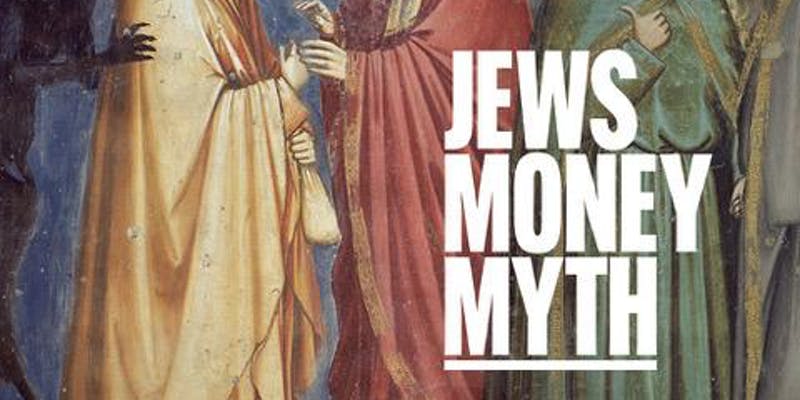
How can museums best confront the stereotypes that feed antisemitism? Join our panel to explore the challenges of exhibiting difficult histories and shaping the stories objects tell.
Coinciding with the major exhibition Jews, Money, Myth, currently showing at the Jewish Museum and developed in collaboration with Birkbeck’s Pears Institute for the study of Antisemitism, Anthony Bale and Marc Volovici, academic advisors to the exhibition, and its curator, Joanne Rosenthal discuss their approach. Chair: Sarah Thomas, Director of the Centre for Museum Cultures.
Jews, Money, Myth runs at the Jewish Museum until 7 July and explores the role of money in Jewish life and its vexed place in relations between Jews and non-Jews, from the time of Jesus to the 21st century. It examines the origins of some of the longest running and deeply entrenched antisemitic stereotypes: the theological roots of the association of Jews with money; the myths and reality of the medieval Jewish moneylender; and the place of Jews – real and imagined – in commerce, capitalism and finance up to the present day. “Next time I’m asked how antisemitism started, I’ll say: ‘go to this exhibition’” Daniel Finkelstein, The Times.
Anthony Bale is Executive Dean of Arts and Professor of Medieval Studies at Birkbeck. His research interests include the histories and theories of ‘antisemitism’, late medieval English literature, culture and popular religion. He served as an academic advisor for Jews, Money, Myth.
Joanne Rosenthal is a freelance curator based in Sheffield. She was formerly Chief Curator and Head of Exhibitions at the Jewish Museum London and served on the board of the Association of European Jewish Museums. Her exhibitions for the Jewish Museum include Jews, Money, Myth and Blood: Uniting and Dividing. Her curatorial interests lie in the representation of difficult histories and explorations of collective memory and identity.
Marc Volovici is a Research Fellow at the Pears Institute. He served as an academic advisor for Jews, Money, Myth, and co-edited the exhibition catalogue. He is completing a book on the language politics of Jewish nationalism.
This event was part of Birkbeck’s annual Arts Week.
Wednesday 15 May, 6pm
The Museum of the Flat Earth: Curating as Art Practice?
Kay Burns and James Mansfield
Keynes Library, 43 Gordon Square
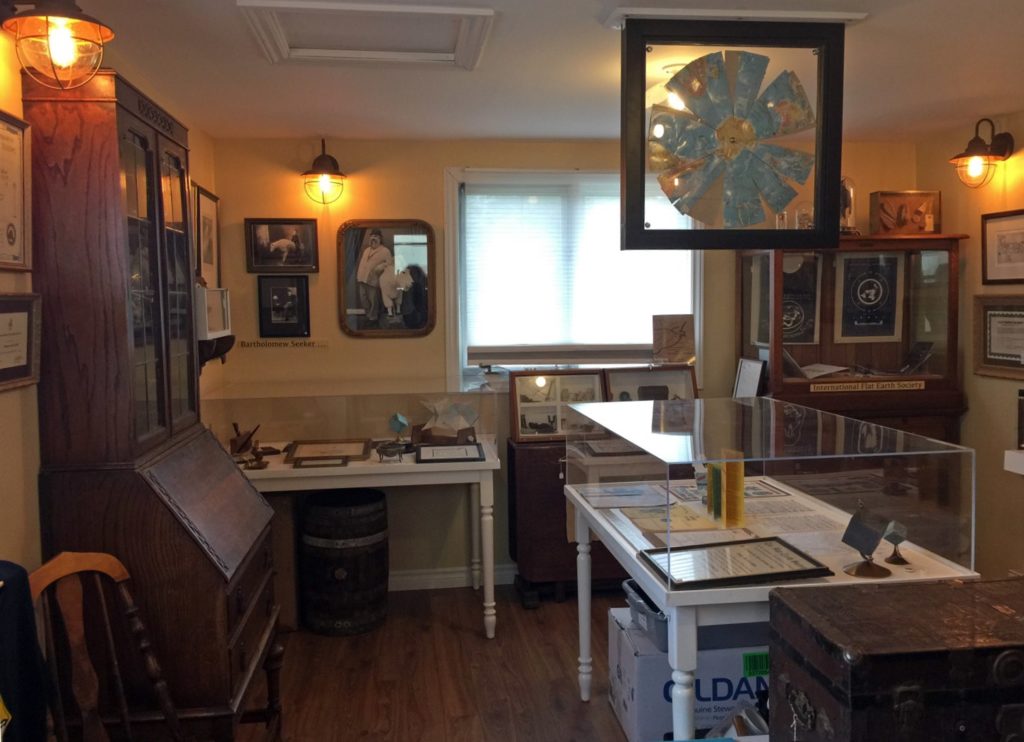
Throughout the 20th Century, artists have sought to be collected and exhibited by museums, and many have also presented critiques of the social and economic structures of museums. More recently, moving away from the expected role of the public art institution, a number of artists have appropriated the physical space, attributes, and authority of museums in the creation of their work, including Kay Burns’ Museum of the Flat Earth. Kay founded this Museum, located on Fogo Island in Newfoundland in 2016, as a repository and adaptation of many years of artistic research and practice.
The Museum combines fictional narrative, historical artefacts, and museological practices with creative performance and interpretation to provide a participatory experience for visitors. Kay will talk about how she came to create the Museum and will also be joined by James Mansfield, artist and PhD candidate at the University of Reading, for a discussion around how the Museum functions as a contemporary artwork and as a work of institutional critique.
Kay Burns is a multidisciplinary artist based in Fogo Island, Newfoundland (Canada). Her work includes performance art, sculpture, photography, audio, installation and locative media. Through her practice, she reinterprets local histories, mythologies, and eccentricities of site and society. A significant aspect of Burns’ research since 2002 has been the reinstatement of the defunct Flat Earth Society of Canada through her performance persona, Iris Taylor. This work has culminated in the creation of the Museum of the Flat Earth, which is both a non-profit museum and an evolving art installation. Her artwork has been presented internationally in Reykjavik, Amsterdam, Belfast, New York and Los Angeles; and across Canada from Dawson City, Yukon to St. John’s, Newfoundland. She previously held the post of curator at the Muttart Public Art Gallery in Calgary, and has taught at the University of Calgary Fine Arts Department and the Alberta University of the Arts.
Friday 3 May
‘Other possible stories. Rethinking the collections of the Museo de Arte de Lima’
Professor Natalia Majluf

El casabe y su origen
Brus Rubio. 2011
Photo: Daniel Giannoni
This presentation attempts to account for the work carried out by a group of curators and experts at the Museo de Arte de Lima over the past two decades. It explores the challenges of incorporating historical and contemporary objects within a panoramic survey collection that spans cultural production in the Andean region from the pre-Columbian period to the present. This effort has contronted the museum with notions of art, time and place that establish oppositions between crucial categories of museological classification: high and popular culture, art and craft, history and ethnography, tradition and modernity, the local and the global. These issues are discussed through examples of specific collecting and research projects related to forms of cultural production traditionally excluded from the museum’s narratives.
Natalia Majluf, currently Simón Bolívar Chair at the University of Cambridge, 2018-2019, is an art historian who works on the long nineteenth century in Latin America, from the era of Independence to the early twentieth century. As Head Curator and Director of the Museo de Arte de Lima, between 1995 and 2018 she oversaw the renovation of the historic building that houses the museum and was responsible for enriching and broadening the scope of the collections. She has held fellowships from the Getty Foundation, the John Simon Guggenheim Memorial Foundation and the Center for Advanced Study in the Visual Arts in Washington, D.C. She is editor, among others, of Los incas, reyes del Perú (2005), Luis Montero’s The funerals of Atahualpa (2011), José Gil de Castro, pintor de libertadores (2014) and has co-authored Tipos del Perú. La Lima criolla de Pancho Fierro (2008), Fernando Bryce. Drawing Modern History (2011), Sabogal (2013) and Chambi (2015), among other books and exhibition catalogues.
Co-hosted by the Centre for Museum Cultures and the Centre for Iberian and Latin American Visual Studies.
Wednesday 1 May
Pakistan’s Best Kept Secret – Lahore Museum
Chandak Sengoopta, Anwar Akhtar, Sarah Thomas
The first UK screening of Pakistan’s Best Kept Secret – Lahore Museum, filmed in and around the extraordinary Lahore Museum and its unique collection of Muslim, Hindu and Buddhist artefacts.
Lahore Museum has a rich, ancient and varied collection which demonstrates the historical wealth, religious and cultural plurality of Pakistan, one of the largest Muslim majority countries in the world, with large diasporic communities across the globe. The film explores the significance of the Museum in Asia, but also in Britain today. Its collection tells stories of ancient cultures: Hindu, Jain, Buddhist, Sikh, Muslim histories, and those of empire, trade, the arrival of the East India company, the contribution of British Indian soldiers in World Wars I and II, the partition of India, and the creation of Pakistan. It also gives some insight into life in Pakistan today.
The film features Anwar Akhtar, British Pakistani journalist and director of samosa media, in conversation with the Lahore Museum’s ex-director Sumera Samad, and playwright Shahid Nadeem (Ajoka Theatre Company). They view the Museum’s collection, and discuss the future role of the institution within Pakistan’s wider social, political, religious and cultural context today as well as Pakistan’s relationships with Britain.
The screening will be followed by a panel discussion featuring Professor Chandak Sengoopta (Department of History, Classics & Archaeology, Birkbeck), Anwar Akhtar, Dr Natasha Eaton (History of Art, UCL), and chaired by Dr Sarah Thomas (Director, Centre for Museum Cultures, Birkbeck). The discussion will consider Lahore Museum’s collection within a global context of sectarian tensions, culture wars and the populist rhetoric of politicians today. It will also ask how films like this can support and embed diversity in museums.
Monday 25 March 2019
Professor Jennifer Tucker and Johnathan Ferguson
‘Curating Firearms in Museums in the 21st Century’
Keynes Library, School of Arts, 43 Gordon Square
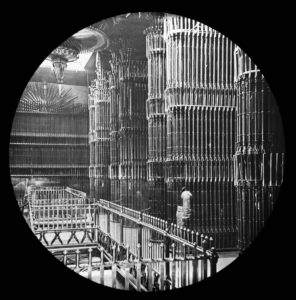
Tower of London, lantern slide, c.1870
Firearms collections and exhibitions share many affinities with other museums of technology. Today, there are around thirty national, state and publically owned collections of firearms in the U.S., as well as hundreds more that are privately owned or in collections on military bases. Even in the UK, with its less extensive historical and contemporary ‘gun culture’, many museum collections contain firearms of one sort or another, although many remain in storage. In both countries firearms collections raise many challenging questions. How do curators of museum firearms collections make choices for exhibition stories, as well as facilitate research and study? This session convenes a historian and a curator to discuss how guns and their histories are exhibited and narrated in American and British museums today.
Jonathan Ferguson is Keeper of Firearms & Artillery at the Royal Armouries Museum in Leeds, UK. He is based at the National Firearms Centre, successor to the Ministry of Defence Pattern Room and one of the most comprehensive firearms collections in the world. His research interests include the use and effect of firearms both historical and modern. He also works with Armament Research Services as a technical specialist. Publications include the article ‘Trusty Bess’: the Definitive Origins and History of the term “Brown Bess” (2017), the book ‘Mauser “Broomhandle” Pistol’ (2017), and a co-authored small arms handbook for field researchers (due 2018).
Jennifer Tucker is Associate Professor of History and Science in Society at Wesleyan University (USA). Her research explores historical relationships of technology, science and culture, and law in nineteenth-century Britain and U.S.: interests which extend to the study of firearms in British and imperial history. She is the editor of the forthcoming book, A Right to Bear Arms? The Contested Role of History in Contemporary Debates on the Second Amendment (Washington, DC: Smithsonian Institution Scholarly Press, 2019), and the moderator of a recent round table discussion in Technology and Culture journal with seven curators of national and local firearms museums on the topic of history and heritage. She also writes about cowboy shoot outs and historical reenactments and the symbolism of guns in the current election ad cycle. A member of the new Association of Firearm Museum Professionals and Historians, she is the recipient of a 2016 National Endowment for the Humanities Public Scholar Award.
The Royal Armouries is the UK’s national museum of Arms & Armour, spanning sites at Leeds, the Tower of London, and Fort Nelson. Its stated purpose is: ‘To excite and educate the public about arms and armour and their impact on the people, history and cultures of Britain and the world from ancient times to the present day’. The Armouries holds in trust for the public one of the finest collections of its type in the world, from exquisite pieces of the gunmaker’s art, to the most functional military weapons, and from the medieval period to the present day. The already impressive firearms collection was more than doubled in size in 2005 by the acquisition of the British Ministry of Defence’s former ‘Pattern Room’ collection.
Friday 1 March 2019
Professor Wendy Shaw
‘Museums and Islamic Art: Whose Culture? Whose Colony?’
School of Arts, 43 Gordon Square
The category of Islamic art begs an ontological problem: it is a category produced by the fact of being studied. Emerging through the accretion of modern art historical methods as applied to cultures distinct from those of Europe, Islamic art history is supposed to translate the culture of the “other” into a language of art that claims universality. To what extent is this practice intrinsically colonial? And to what extent can culture nonetheless come to be expressed in the interstices between our claims to knowledge? This talk examines how Islamic art history emerges from methodological art historical layers, and becomes globalised in the modern era, both as a representation of Islam and as a representation of power, ultimately to ask how our rich collections might also speak otherwise.
Wendy M. K. Shaw (Ph.D. UCLA, 1999) is Professor of the Art History of Islamic cultures at the Free University Berlin. Her work focuses on the impact of coloniality on art-related institutions, modern art and pre-modern discourses of perception, with emphasis on the Ottoman Empire and regions of Islamic hegemony. She has written Possessors and Possessed: Museums, Archaeology, and the Visualization of History in the Late Ottoman Empire (University of California Press, 2003), Ottoman Painting: Reflections of Western Art from the Ottoman Empire to the Turkish Republic (IB Tauris, 2011), and What is “Islamic” Art: Between Religion and Perception (Cambridge University Press, forthcoming).
10 December 2018
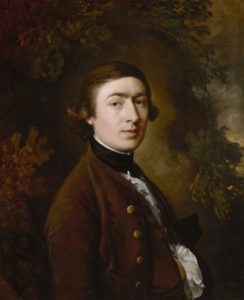
NPG 4446. Thomas Gainsborough by Thomas Gainsborough. Oil on canvas, circa 1759. © National Portrait Gallery, London
Meet the Curator at the National Portrait Gallery
Dr Lucy Peltz, Head of Collection Displays (Tudor to Regency) and Senior Curator 18th Century Collections, gave an informal talk and answered questions in Gainsborough’s Family Album about her role in co-curating this fascinating exhibition.
22-23 November 2018
Conference: Classical Material Culture in the 19thCentury
Organised by the Birkbeck Centre for Nineteenth Century Studies
19 October 2018, 6pm
‘Design for a Nation: The Victoria and Albert Museum in the 21st Century’
Birkbeck History of Art Anniversary Lecture
Dr Tristram Hunt, Director, V&A
Dr Tristram Hunt is Director of the V&A: the world’s leading museum of art, design and performance. He will discuss how the museum’s founding commitment to design, education and industry continues to define it today. Tracing the museum’s genesis, from its Victorian roots in the Design School Movement of the 1830s, through the Great Exhibition of 1851, to its establishment in 1852 as the Museum of Manufactures, he considers how the V&A’s British, Germanic, Indian and Oriental origins engendered a world-class collection. In our contemporary age of Brexit, Netflix and digital technology, Dr Hunt uses this cultural lens to consider the museum’s place in the world today.
Dr Hunt’s lecture will be followed by a drinks reception and the launch of the Centre for Museum Cultures.
6pm–8pm: Beveridge Hall, Senate House WC1E 7HU

